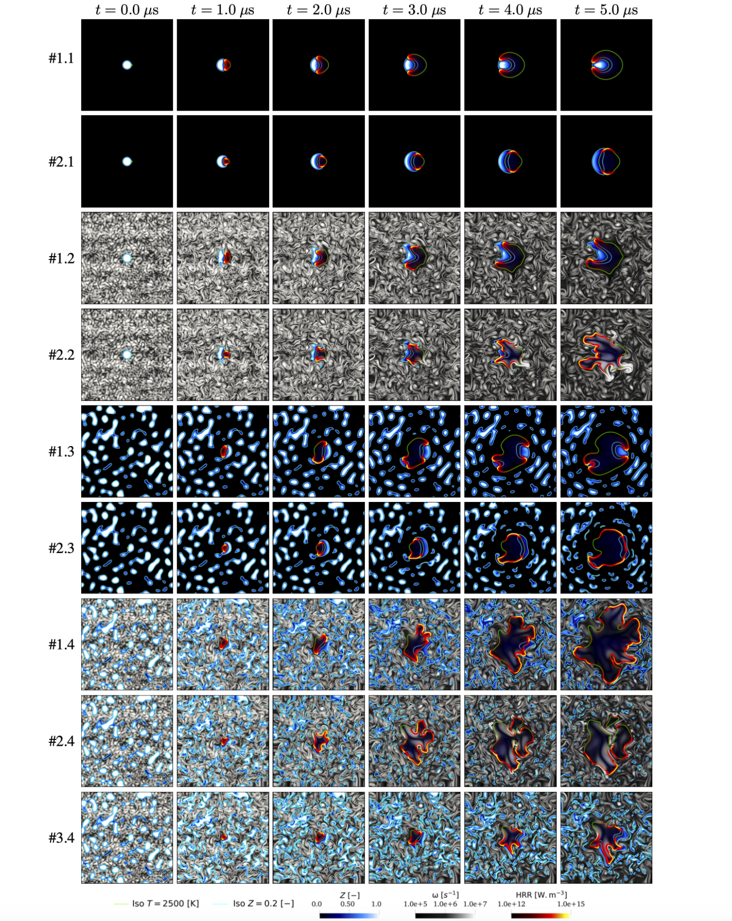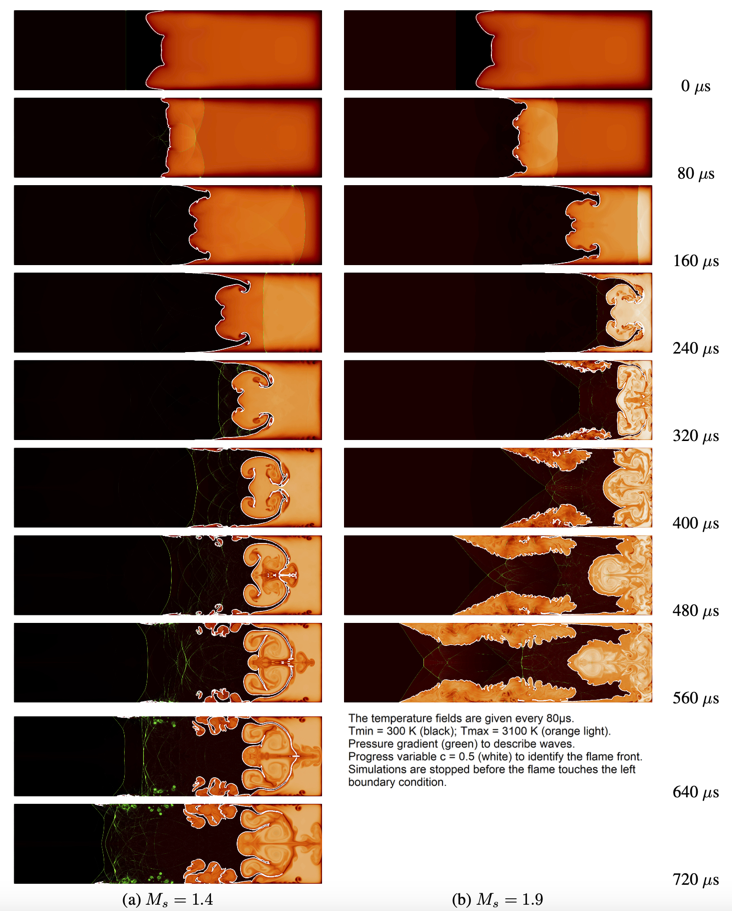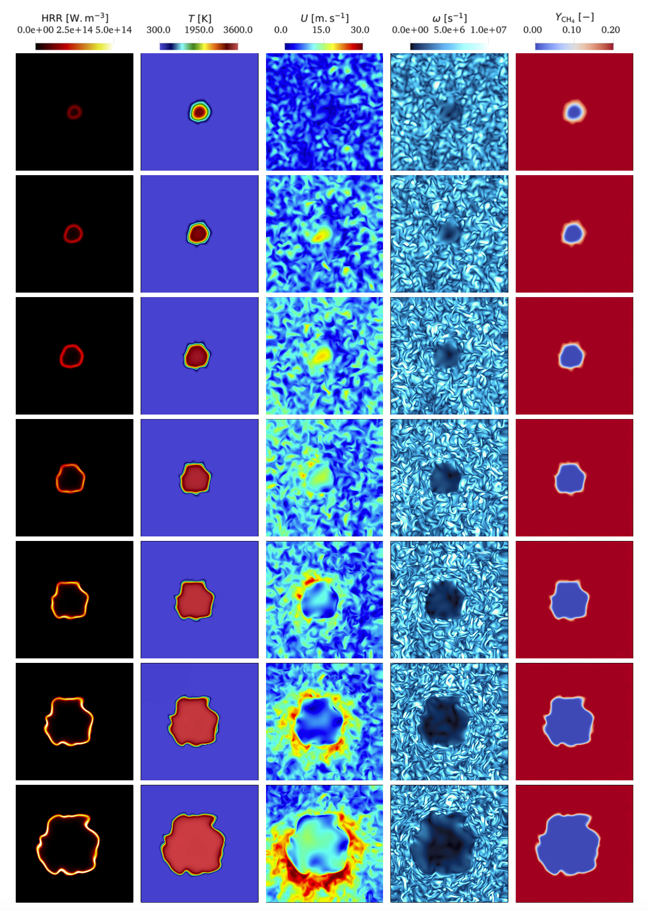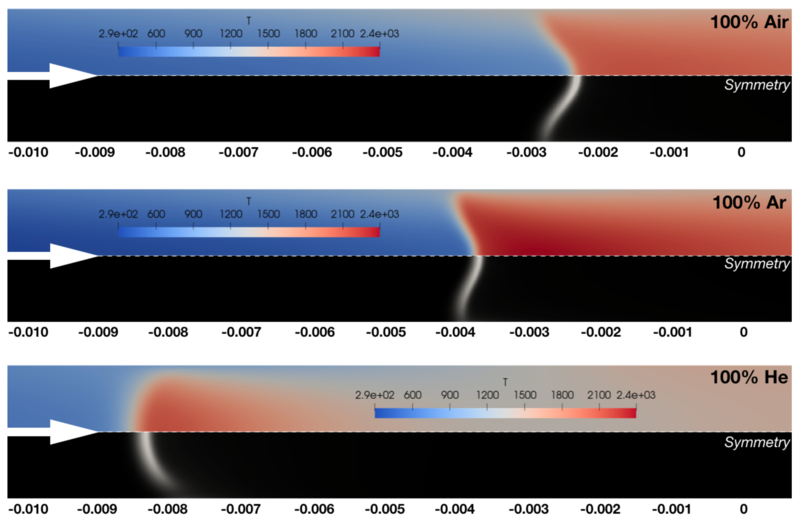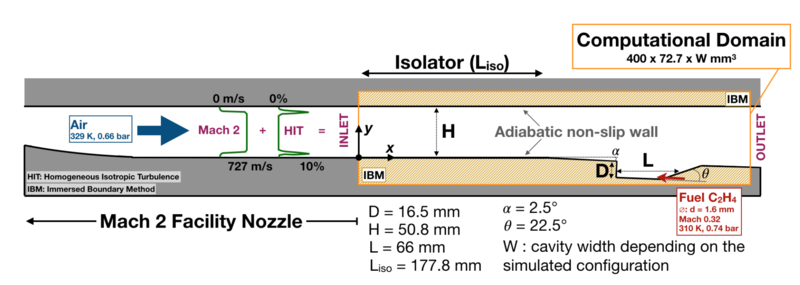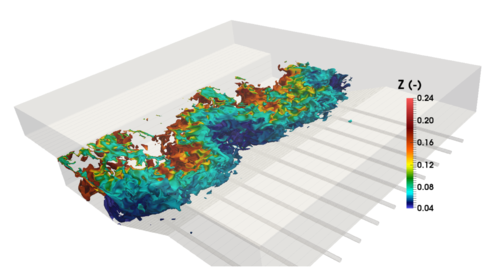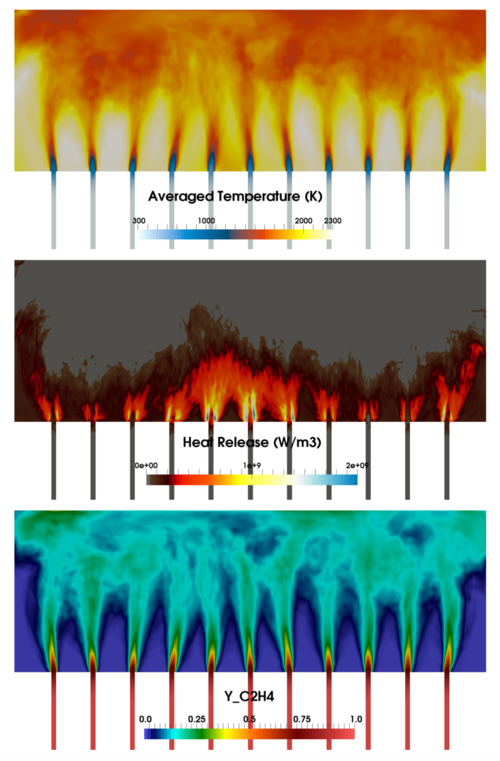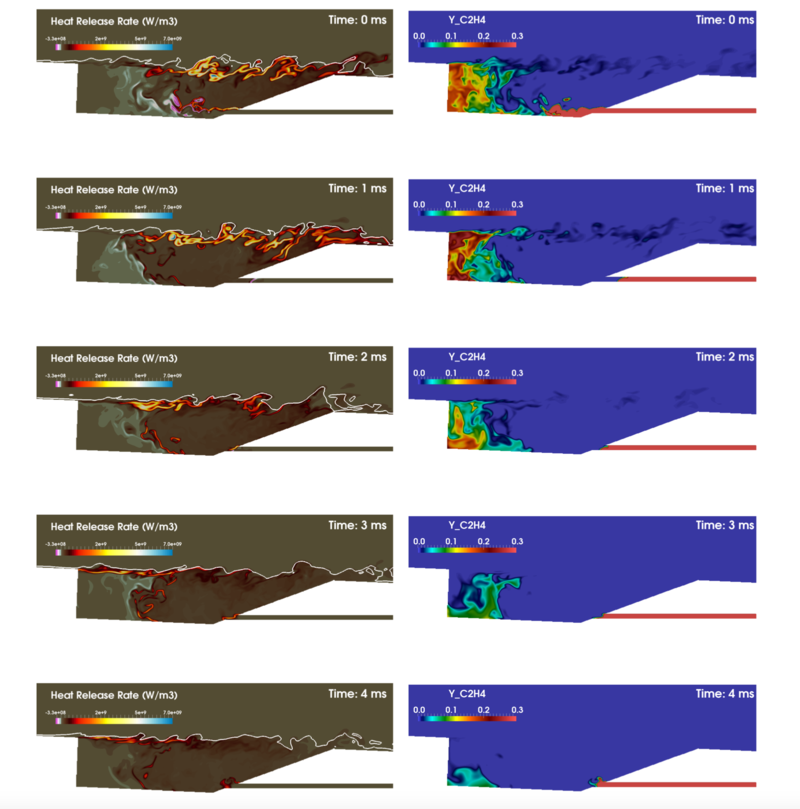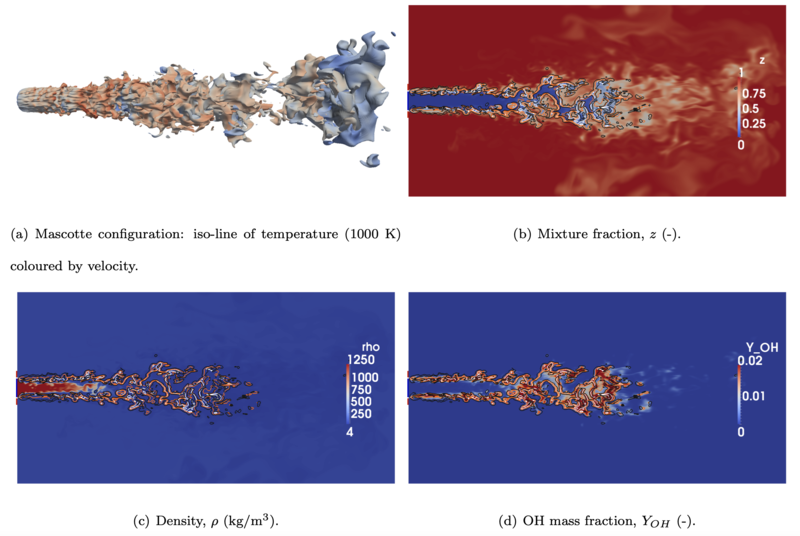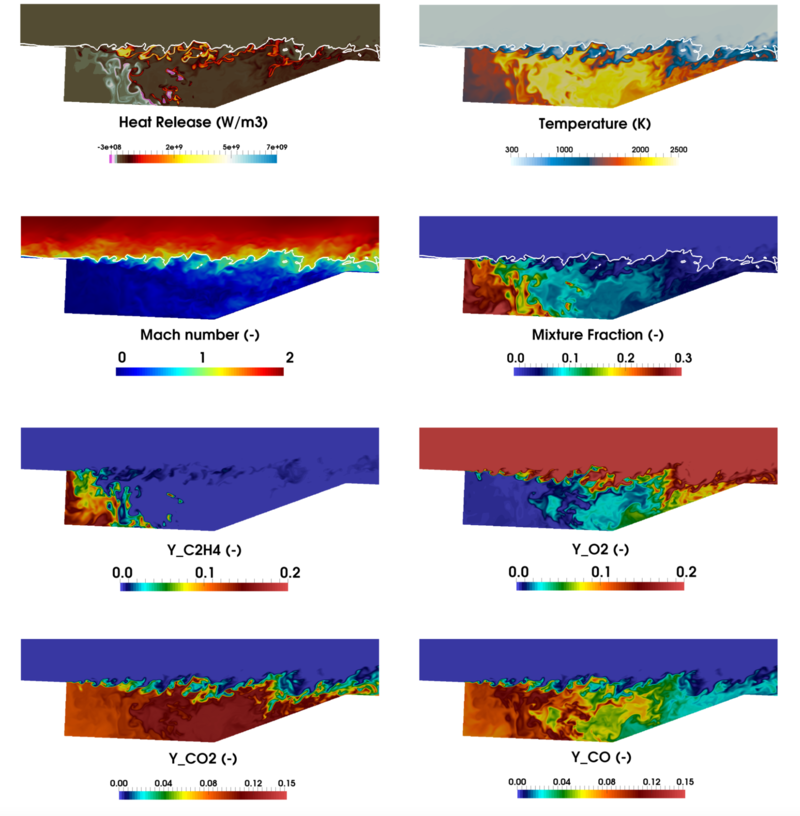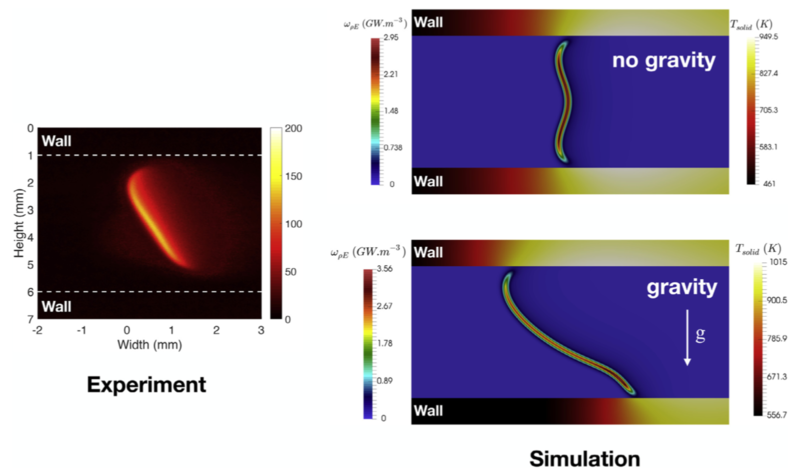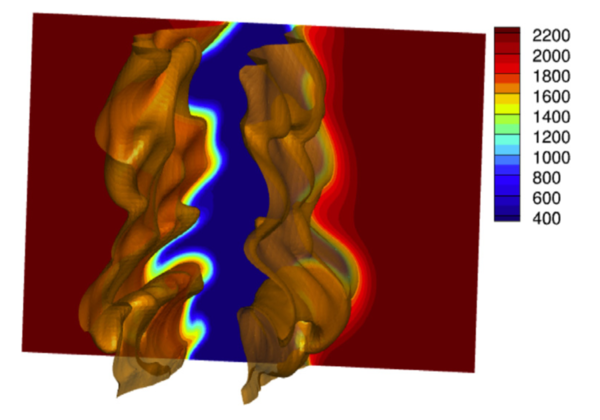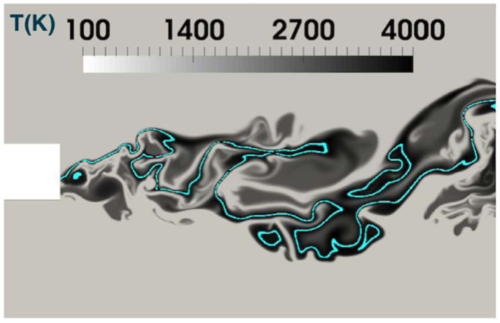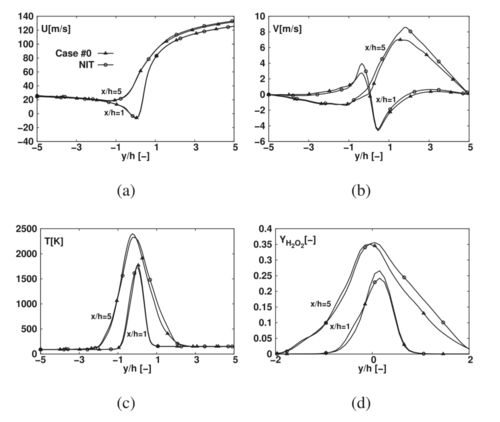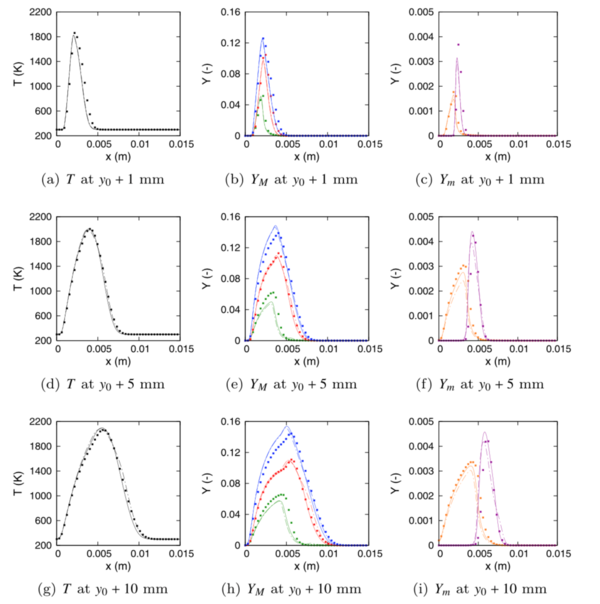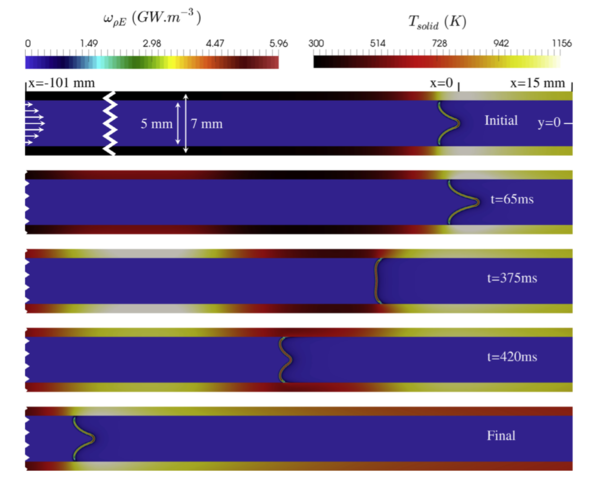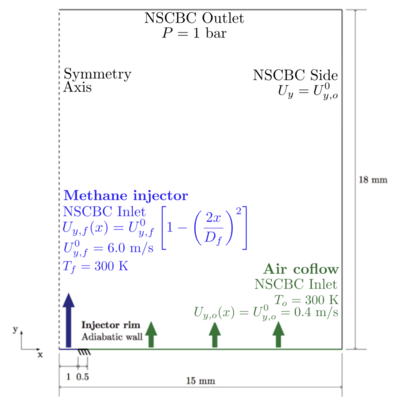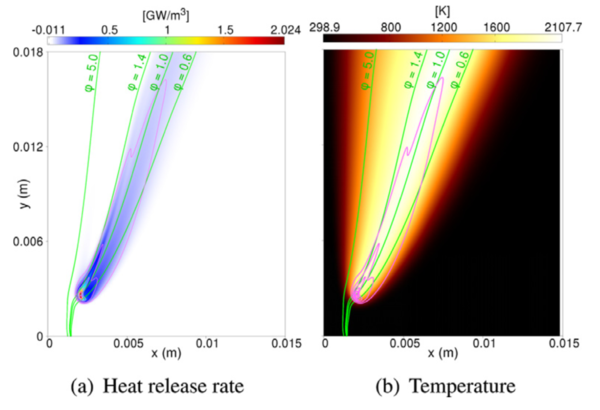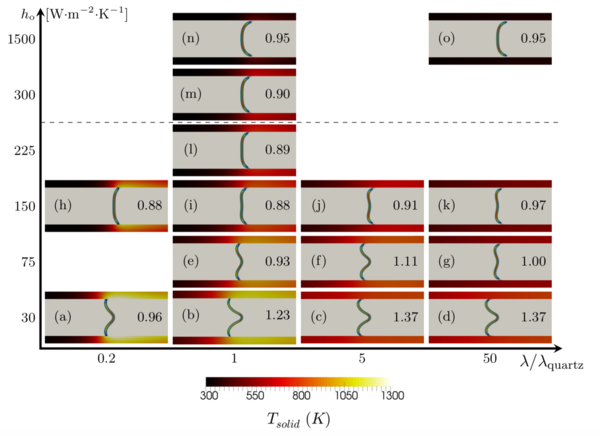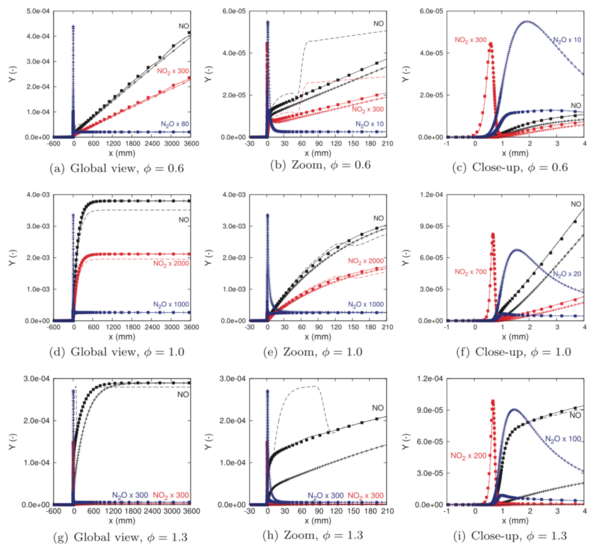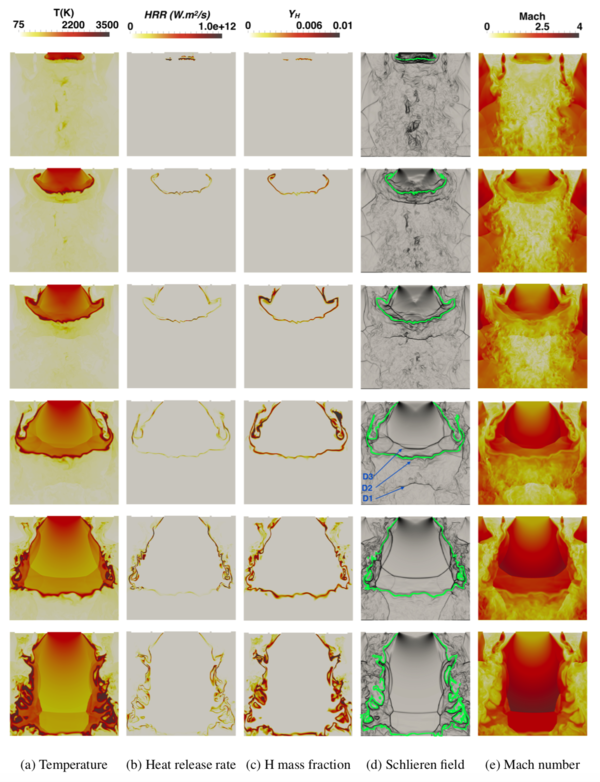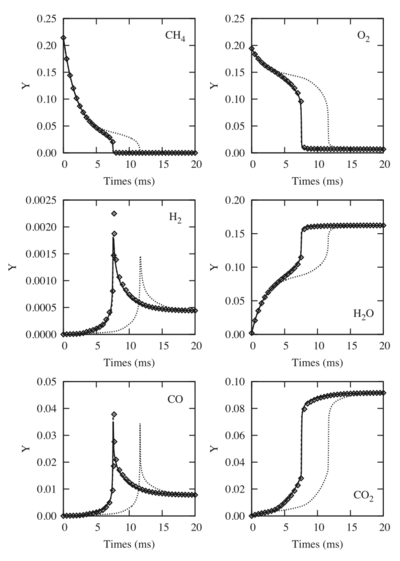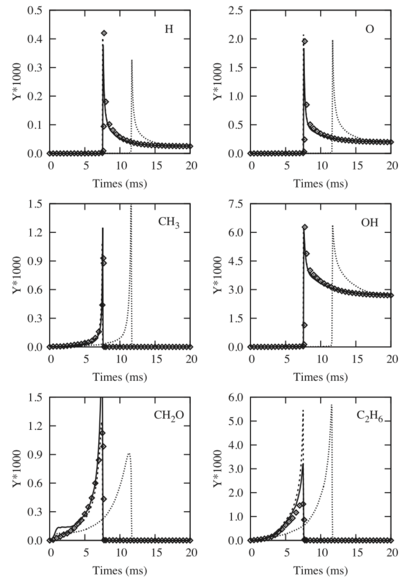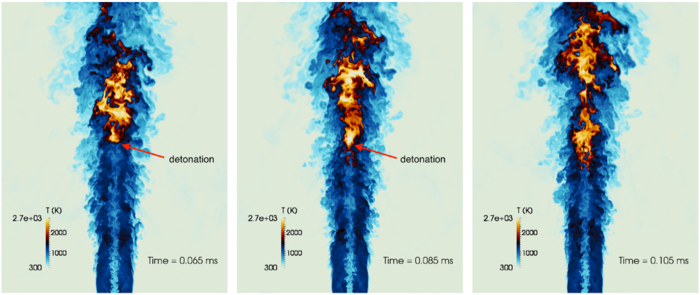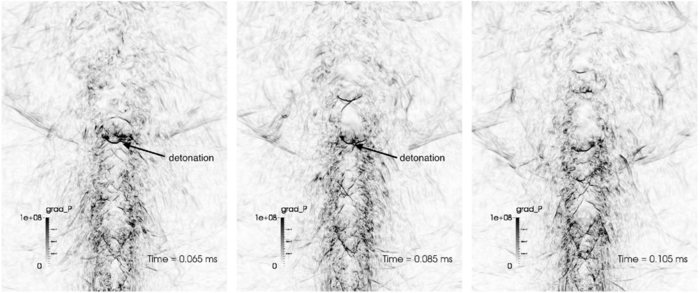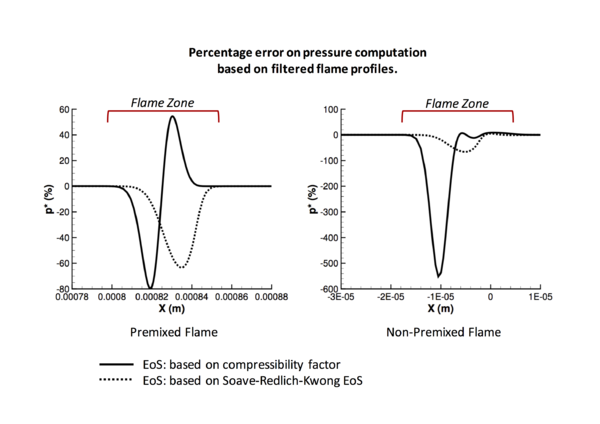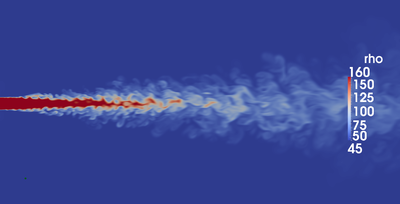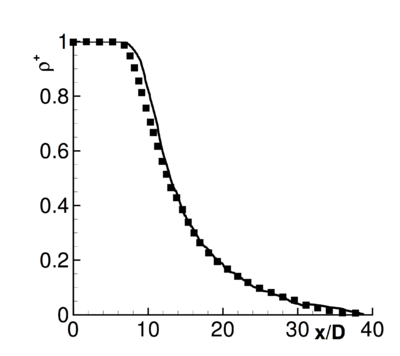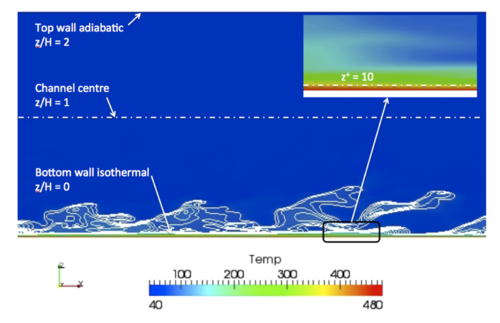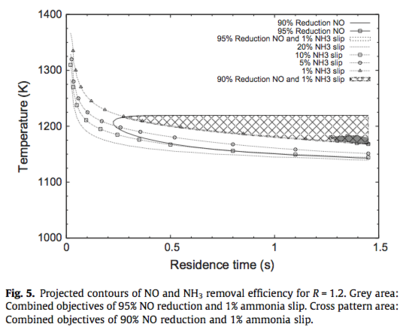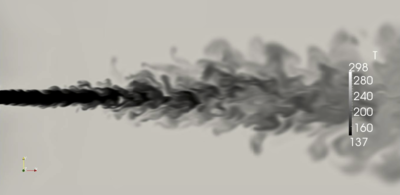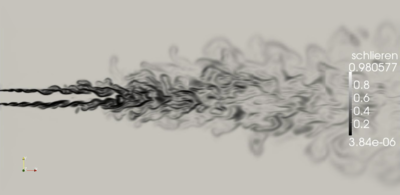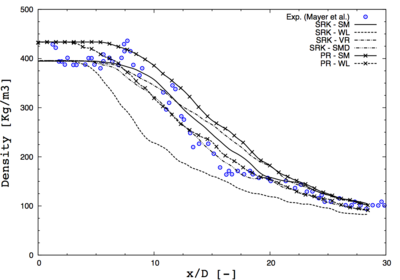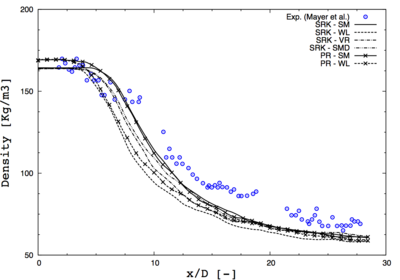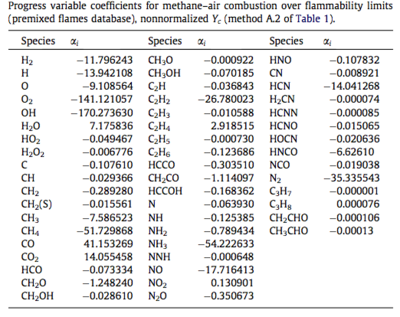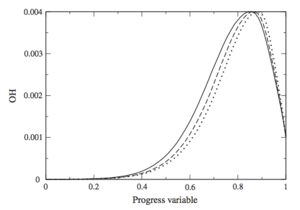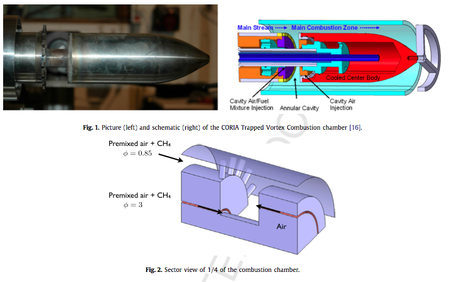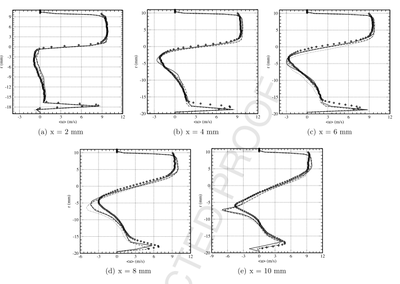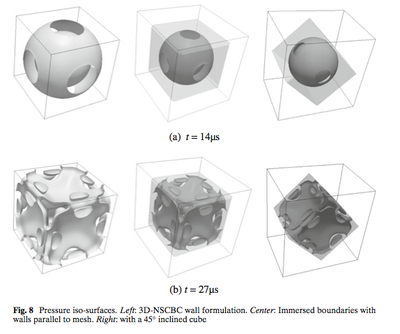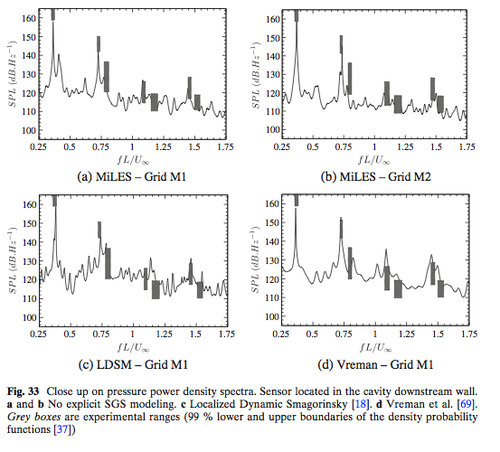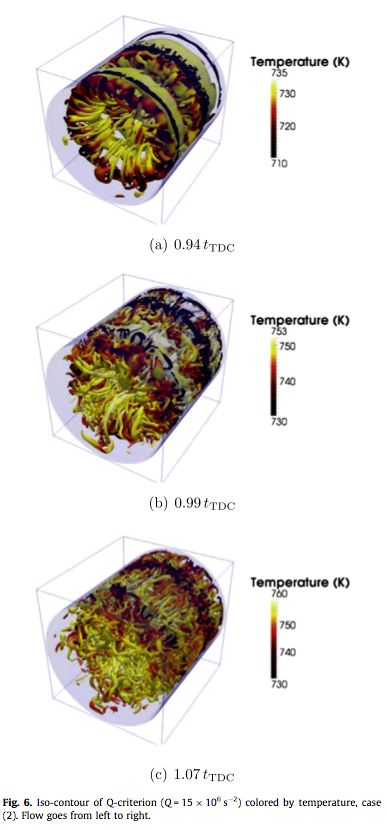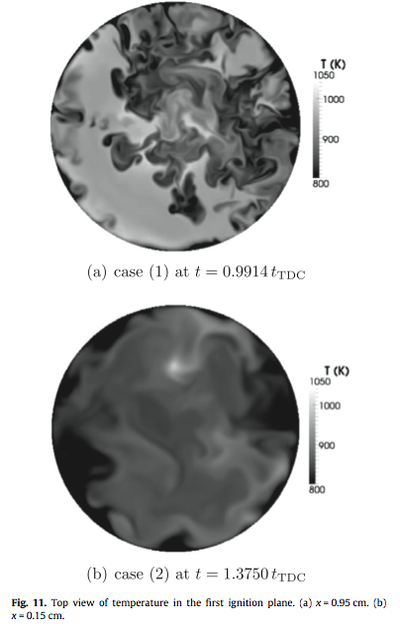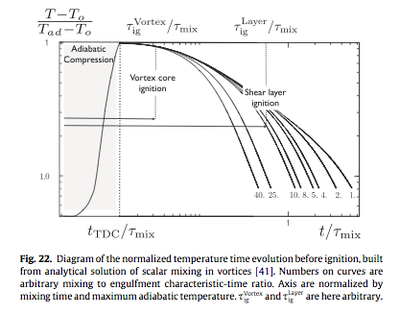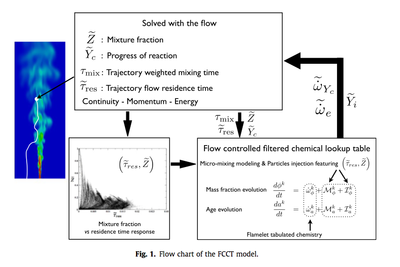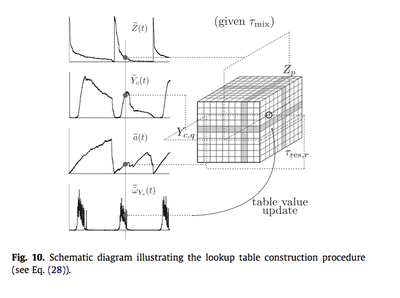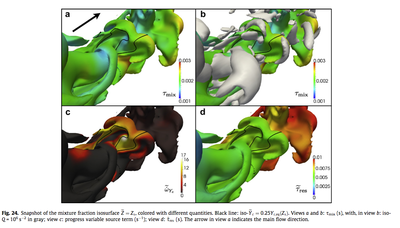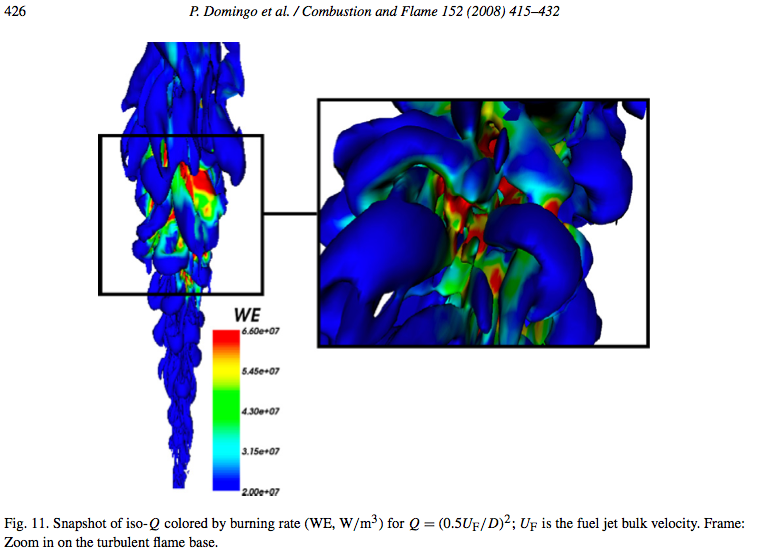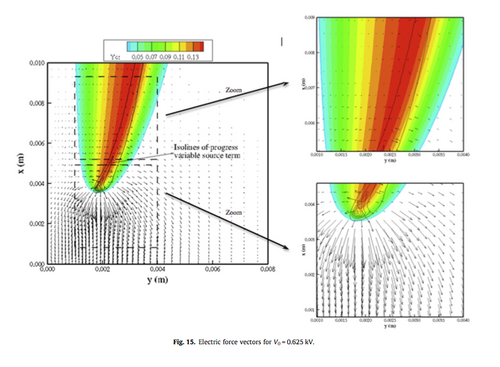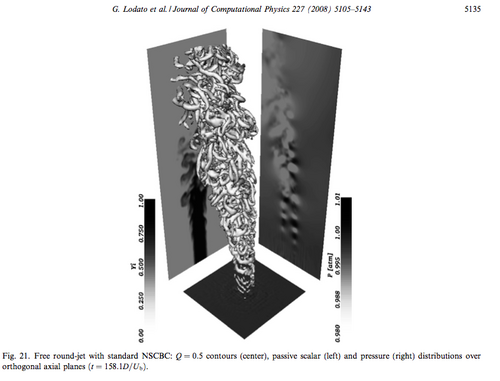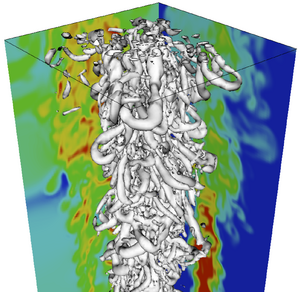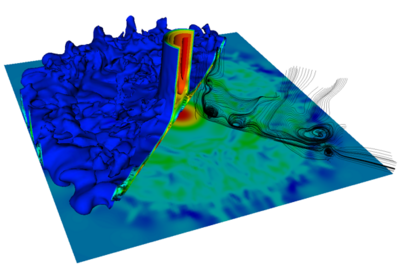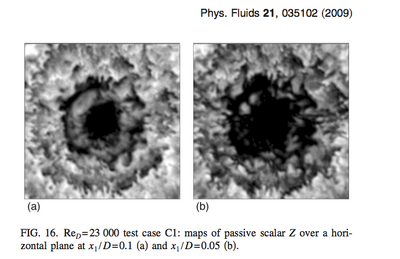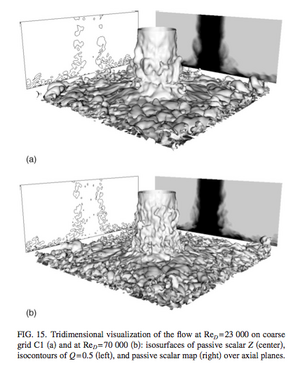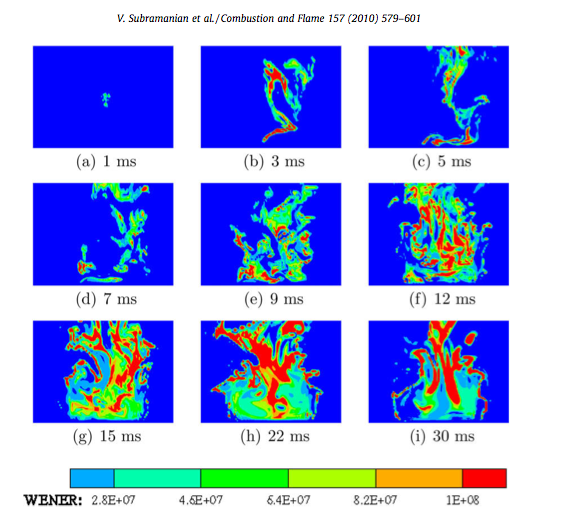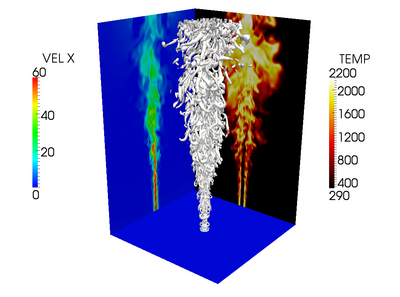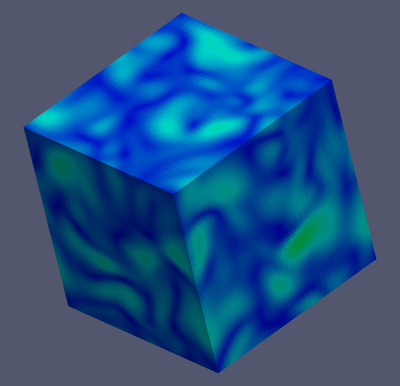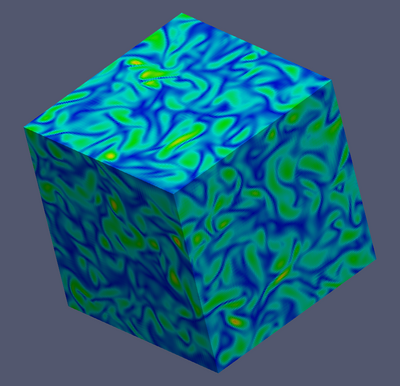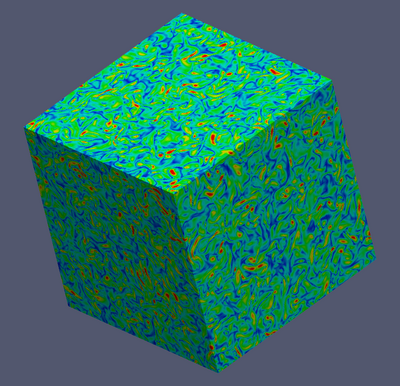Difference between revisions of "SiTCom-B Gallery"
(→Numerical simulations of supercritical CH4/O2 flame propagation in inhomogeneous mixtures following ignition) |
|||
| (60 intermediate revisions by 2 users not shown) | |||
| Line 1: | Line 1: | ||
| + | == Numerical simulations of supercritical CH4/O2 flame propagation in inhomogeneous mixtures following ignition == | ||
| + | |||
| + | The propagation of flames in non-homogeneous medium is studied for the particular case of the combustion of methane with oxygen at high pressure, in supercritical regime. A reduced chemistry containing 17 species and 44 elementary reactions is used in two configurations: 1/ a pocket of methane in a steady environment of oxygen at 10 MPa, and 2/ a double transcritical injection in a splitter plate configuration at 5.4 MPa. High fidelity simulations are carried out with the real gas version of the SiTCom-B numerical code. The addition of a hot spot to the reactive mixtures resulted in the formation of triple flames propagating along the stoichiometric isoline whatever the configuration chosen: with or without turbulence, cryogenic temperatures, random distribution of methane or not. In the case of a high density ratio between the two fluids (CH4 and O2), the flame naturally chooses to move towards that of lower density. In the case of the combustion of one pocket of methane, the addition of a homogeneous isotropic turbulence promotes combustion by increasing the length of the flame as well as the lean premixed combustion mode compared to the rich or non-premixed combustion. A similar behavior is observed when the pocket of CH4 is replaced by a set of random pockets. In the case of the splitter plate, tribachial flames propagating along the stoichiometric line are observed again. Combustion develops in finger-like structures mostly with a non-premixed mode of combustion. However, the lean and rich premixed combustion remains and the flame spreads towards the injector. The tip of the flame then attempts to pull up the flow into a reduced space stuck between dense oxygen and a rapid flow of methane. | ||
| + | {| class="wikitable" | ||
| + | |+ Supercritical Combustion | ||
| + | |- | ||
| + | | [[File:FOM2.png|center|800px]] | ||
| + | |- | ||
| + | | Blob(s) of methane into pure oxygen. Temporal evolution of heat release rate (HRR) superposed with vorticity (ω) and mixture fraction (Z) according to the case number (w/o HIT, 1 or random blobs, temperature for methane or oxygen). Isolines: Zst in blue, T = 2500 K in green. The radius of the initial hot spot is rhs = 3Lbox/120. The full domain of simulation is shown. | ||
| + | |- | ||
| + | |} | ||
| + | |||
| + | *F. Monnier, G. Ribert (2022) Numerical simulations of supercritical CH4/O2 flame propagation in inhomogeneous mixtures following ignition, Proc. Combust. Inst. (in press). [https://www.sciencedirect.com/science/article/abs/pii/S1540748922002437?via%3Dihub link] | ||
| + | |||
| + | == Numerical simulation of laminar premixed hydrogen-air flame/shock interaction in semi-closed channel == | ||
| + | |||
| + | Highly refined simulations of flame/shock interactions (FSI) are performed and analyzed in the context of hy- drogen/air combustion in a two-dimensional shock-tube configuration (height 7 cm). The chemical mechanism used for the hydrogen oxidation contains 9 reactive species, without nitrogen oxides, and 23 kinetic reactions. An initially planar laminar premixed flame (φ = 0.8) is left to evolve until the ratio between its burning flame velocity and the laminar flame speed reaches 1.45. Two thermal wall boundary conditions are envisaged: isothermal with Twall fixed to 300 K and adiabatic. The species transport is described with a unity Lewis number for all species or by complex transport. Once the flame is established, a shock is installed in the domain which propagates toward the flame. Two values of the Mach number for the incident shock are considered: Ms = 1.4 and Ms = 1.9. The relative impacts of the wall thermal condition, of the species transport modeling and of the incident shock Mach number on the FSI process are discussed. It is observed that thermal boundary conditions and transport modeling have a weak impact in the first stages of the FSI but a significant one once the reflected shock crosses the flame front. | ||
| + | {| class="wikitable" | ||
| + | |+ Supersonic Combustion | ||
| + | |- | ||
| + | | [[File:EmY.png|center|800px]] | ||
| + | |- | ||
| + | | Temporal flow evolution of an incident shock (Ms) coming from the left and interacting with an H2/air flame before reflecting on the right side wall. Isothermal walls (top, bottom and right side), complex transport properties, ∆xi = 31.25 μm. | ||
| + | |- | ||
| + | |} | ||
| + | |||
| + | *E. Yhuel, G. Ribert, P. Domingo (2022) Numerical simulation of laminar premixed hydrogen-air flame/shock interaction in semi-closed channel, Proc. Combust. Inst. (in press). [https://www.sciencedirect.com/science/article/abs/pii/S1540748922005193?dgcid=coauthor link] | ||
| + | |||
| + | == Simulation of high-pressure methane-oxygen combustion with a new reduced chemical mechanism == | ||
| + | |||
| + | The modeling and simulation of methane-oxygen combustion at high pressure requires a dedicated kinetic mechanism to obtain a precise description of the fuel decomposition. However, using the detailed mech- anisms literature in high-fidelity simulations, like direct numerical simulations, is not possible due to the high numerical cost. Accordingly, a reduced chemical mechanism is required, and the one proposed in this study contains 17 species and 44 reactions to encompass a very large range of pressure (P ∈ [1, 100] bar) and equivalence ratio (φ ∈ [0.2, 14]). The Optimized and Reduced Chemistry method, that is based on directed relation graph with error propagation, is applied to the RAMEC kinetic scheme, and validations are performed for a set of canonical test-cases: auto-ignition delay simulation, one-dimensional laminar premixed flame freely propagating and one-dimensional counterflow diffusion flame. A very good agree- ment is obtained by comparison with the RAMEC detailed mechanism. To further evaluate the ability of the reduced mechanism, a premixed flame expanding in a homogeneous isotropic turbulence at high pressure (P = 56 bar) is performed. The temporal evolution of the flame front is detailed from its ignition, revealing the flame behavior and its interaction with turbulence. The new reduced chemical mechanism performs well with a relative error of 4% for the maximum of temperature at each time step and even less if the difference observed in the auto-ignition times between the two mechanisms is considered. Finally, a substantial gain is found when using the reduced scheme on three-dimensional cases, the simulations being 8 times faster than those using the detailed scheme. A dedicated post-processing tool based on the contour tracing labeling method is developed to measure the flame length. | ||
| + | {| class="wikitable" | ||
| + | |+ Supercritical Combustion | ||
| + | |- | ||
| + | | [[File:FMO.png|center|800px]] | ||
| + | |- | ||
| + | | 3D simulations: scalar fields of heat release rate (HRR), temperature (T), velocity magnitude U, vorticity (ω) and species mass fraction for CH4 (YCH4) is given from t = 2 × 10−7 s (top) to t = 1.4 × 10−6 s (bottom), each ∆t = 2 × 10−7 s. P = 56 bar, Φ = 1, T = 300 K in the fresh mixture. | ||
| + | |- | ||
| + | |} | ||
| + | |||
| + | *F. Monnier, G. Ribert (2022) Simulation of high-pressure methane-oxygen combustion with a new reduced chemical mechanism, Combust. Flame (235): 111735. [https://www.sciencedirect.com/science/article/abs/pii/S0010218021004788?via%3Dihub link] | ||
| + | |||
| + | == Experimental and numerical studies of the diluent influence (N2, Ar, He, Xe) on stable premixed methane flames in micro-combustion == | ||
| + | |||
| + | This work focuses on the diluent influence on stable methane flames in a fused silica micro flow reactor (MFR). Experimental and numerical investigations are performed. The first part presents the method of performing experiments and ex- tracting data from an MFR in order to increase the reliability of the communication of the results. Those methods are applied to premixed stoichiometric methane flames diluted by nitrogen, argon, helium and xenon. Methods to point out the influence of mixture thermodynamic and transport properties influence is presented. A numerical study of the influence of diluent on stable flames is also undertaken to support the experimental observations difficult to realize in such micro-devices. | ||
| + | {| class="wikitable" | ||
| + | |+ Micro-combustion | ||
| + | |- | ||
| + | | [[File:icare.png|center|800px]] | ||
| + | |- | ||
| + | | Numerical simulation of a premixed flame of methane with O2+N2 (top), O2+Ar (middle) and, O2+He (bottom). In black: the heat release rate that define the flame position. In color, the temperature field. Abscissa in meters. | ||
| + | |- | ||
| + | |} | ||
| + | |||
| + | *H. Chouraqui, G. Dayma, G. Ribert, F. Halter, C. Chauveau, P. Dagaut (2020) Experimental and numerical studies of the diluent influence (N2, Ar, He, Xe) on stable premixed methane flames in micro-combustion Proc. Combust. Inst. Volume 38, Issue 4, 2021, Pages 6753-6761. [https://www.sciencedirect.com/science/article/pii/S1540748920304181?via%3Dihub link] | ||
| + | |||
| + | == Simulation of a Scramjet Combustor: A Priori Study of Thermochemistry Tabulation Techniques == | ||
| + | |||
| + | Large eddy simulations (LES) of a scramjet combustor are reported in this paper. The case under study is a cavity-based combustion chamber that is experimentally studied at the U.S Air Force Research Laboratory. The chamber is fed by eleven injectors. The computational domains are either simplified including only one or two injectors or complete with the 11 injectors. A good agreement is found between experimental data (velocities measured by PIV) and results from the LES if the kinetic used is chosen with care. A high temperature is found inside the cavity promoting a reactive zone located in the mixing layer where the flow velocity is high. At this location, the combustion occurs first in a diffusion dominated regime followed by the efficient burning of a well mixed mixture (rich then lean). A significant diffusion dominated burning is also found inside the cavity, mostly at the interface between the two recirculation zones. The simulation of the complete geometry revealed a transverse phenomenon on the temperature and mixing fields, but which had nevertheless little effect on the comparison with the available experimental data. | ||
| + | A tabulation of the chemistry based on a premixed flamelet library without compressibility effects has been tested a priori on the results of the simulation with one injector. Good results on temperature and H2O fields are found. Significant localized discrepancies appeared on CO and CO2 fields due to the complexity of the combustion regimes, while compressibility effects were found to be weak for the configuration studied. | ||
| + | {| class="wikitable" | ||
| + | |+ Scramjet simulation | ||
| + | |- | ||
| + | | [[File:ruan41.png|center|800px]] | ||
| + | |- | ||
| + | | Sketch of the AFRL supersonic wind tunnel. | ||
| + | |- | ||
| + | | [[File:ruan42.png|center|500px]] | ||
| + | |- | ||
| + | | Instantaneous isosurface of temperature at 2000 K for 11 injectors, colored by the values of mixture fraction. | ||
| + | |- | ||
| + | | [[File:ruan43.png|center|500px]] | ||
| + | |- | ||
| + | | Simulation with 11 injectors. | ||
| + | |- | ||
| + | |} | ||
| + | |||
| + | *J. Ruan, L. Bouheraoua, P. Domingo, G. Ribert (2021) Simulation of a Scramjet Combustor: A Priori Study of Thermochemistry Tabulation Techniques Flow, Turbulence and Combustion, Volume 106, pages 1241–1276. [https://link.springer.com/article/10.1007/s10494-020-00184-4 link] | ||
| + | |||
| + | == Stabilization and extinction mechanisms of flames in cavity flameholder scramjets == | ||
| + | |||
| + | Stabilizing a flame in scramjet engines is a current technological challenge. Indeed, the residence time in the combustion chamber is very short, thus limiting the mixing efficiency and consequently, the combustion. This problem is presently addressed by simulating the scramjet combustor of the U.S Air Force Research Laboratory in which ethylene is injected from the back of a slanted cavity to react with the supersonic airflow. Large-Eddy Simulations (LES) are performed for different cases showing a dependence of the combustion regimes encountered in the scramjet cavity with the fuel flow rate. For a medium-high flow rate, a mix of lean and rich premixed reaction zones is found along with non-premixed flames. At medium flow rate, rich premixed flames disappear but the flame remains stable in the cavity. The mechanism of flame stabilization is detailed and the LES tool has proven its efficiency in such challenging configuration. Finally, a mechanism of extinction is proposed when the fuel flow rate is further reduced. | ||
| + | {| class="wikitable" | ||
| + | |+ Scramjet simulation | ||
| + | |- | ||
| + | | [[File:ruan3.png|center|800px]] | ||
| + | |- | ||
| + | | Snapshots of heat release rate (left) and C2H4 mass fraction (right) at injector centerplane for a lean fuel loading, presented every ms from t = 0 to 4 ms. | ||
| + | |- | ||
| + | |} | ||
| + | |||
| + | *J. Ruan, G. Ribert, P. Domingo (2021) Stabilization and extinction mechanisms of flames in cavity flameholder scramjets Combust. Theory Model. Volume 25, Issue 2, Pages 193-207. [https://www.tandfonline.com/doi/full/10.1080/13647830.2020.1845806 link] | ||
| + | |||
| + | == Modelling and simulations of high-pressure practical flows == | ||
| + | |||
| + | In this study, it is intended to summarize the different steps required to address the problem of turbulent combustion modeling for supercritical fluids in practical situations. The following developments can be considered either for rocket or diesel applications, i.e. combustion of hydrogen or hydrocarbon. Very few specific developments have been so far. Indeed, for large-eddy simulations only equilibrium chemistry or laminar chemistry have been used limiting the impact of provided results. The standard tabulated approach that incorporate detailed chemistry features is presently extended to real gas flows. The required steps for the development of a numerical fully compressible LES/DNS solver accounting for real gas features is proposed. A strategy to handle detailed chemistry into numerical simulations is given with a direct application on Mascotte test-bench. | ||
| + | {| class="wikitable" | ||
| + | |+ Mascotte test-bench simulation | ||
| + | |- | ||
| + | | [[File:ruan1.png|center|800px]] | ||
| + | |- | ||
| + | | LES of supercritical combustion: 3D view of the Mascotte configuration (a). Instantaneous flow field of (b) mixture fraction, (c) density and (d) OH mass fraction obtained with 3D simulation: only a 2D plane passing through the center axis is shown. White line: stoichiometric isoline (z = 0.2). Orange line: temperature isoline (T = 2000 K). Black line: isoline of chemical source term for ρYc (ω = 6000 kg.m−3 .s−1 ). | ||
| + | |- | ||
| + | |} | ||
| + | |||
| + | *G. Ribert, P. Domingo, X. Petit, N. Vallée, J.-B. Blaisot (2020) Modelling and simulations of high-pressure practical flows (pp: 629-676), AIAA Book Series: High-Pressure Flows for Propulsion Applications (J. Bellan), Print ISBN 978-1-62410-580-7, (2020). [https://arc.aiaa.org/doi/abs/10.2514/5.9781624105814.0631.0678 link] | ||
| + | |||
| + | == Analysis of combustion modes in a cavity based scramjet == | ||
| + | |||
| + | Large eddy simulations (LES) of non reactive and reactive flows in a cavity-based scramjet com- bustor configuration from the U.S Air Force Research Laboratory (AFRL) are performed. These simulations feature a 22 species and 206 reactions chemical scheme for ethylene/air. The ability of LES to reproduce the main features found in the experiment is first emphasized such as the average velocity field and the stability of the combustion depending on the mass flow rate of ethylene injected at the cavity floor. The influence of the mesh resolution and of the thermal wall condition on the simulation results is also investigated along with the soundness of the use of a laminar model for the filtered source terms. The results of the simulations with the finest grid (resolution of 100 micrometers in the flame region) are then employed to gain understanding in the flame dynamics for which the combustion is stable. This reactive simulation shows the persistence of the two recirculation zones already present in the non reactive flow. The globally high tempera- ture into the cavity helps to sustain a reactive zone located in the mixing layer above the cavity. Combustion first occurs in a diffusion dominated regime followed by the efficient burning of a well stirred mixture (rich then lean). A significant diffusion dominated burning is also found inside the cavity. The link between the residence time inside the cavity and the efficiency of the combustion are explored along with the velocity/heat release correlation. | ||
| + | {| class="wikitable" | ||
| + | |+ Scramjet simulation | ||
| + | |- | ||
| + | | [[File:ruan2.png|center|800px]] | ||
| + | |- | ||
| + | | Instantaneous fields of heat release rate, temperature and mixture fraction, and mass fractions of C2H4, O2, CO and CO2 (fine mesh). The isoline Mach = 1 is displayed with a white line. | ||
| + | |- | ||
| + | |} | ||
| + | |||
| + | *J. Ruan, P. Domingo, G. Ribert (2020) Analysis of combustion modes in a cavity based scramjet, Combust. Flame (215): 238 - 251. [https://www.sciencedirect.com/science/article/abs/pii/S0010218020300468?CMX_ID=&SIS_ID=-1&dgcid=STMJ_75273_AUTH_SERV_PPUB&utm_acid=12632792&utm_campaign=STMJ_75273_AUTH_SERV_PPUB&utm_dgroup=Email1Publishing&utm_in=DM654623&utm_medium=email&utm_source=AC_30&utm_term=Email%201%20Publishing link] | ||
| + | |||
| + | == The role of gravity in the asymmetry of flames in narrow combustion chambers == | ||
| + | |||
| + | The symmetry breaking of a fuel lean premixed laminar methane/air flame, propagating in a horizontal narrow tube of internal diameter li = 5 mm, is investigated experimentally and numerically. The methane/air flame numerical simulations performed include complex molecular transport and chemistry, and the fully coupled solving of heat transfer at and within the wall. In place of a symmetric flame, experiments show the stability of a slanted flame with a preferential anchoring at the top. This is observed for both flames freely propagating along isothermal walls (T = 300 K), and flames stabilised by the incoming flow and thermally coupled with heat transfer inside the walls. Numerical simulations with and without gravity demonstrate its preponderant contribution in the symmetry breaking. The slight flow stratification is sufficient to break the symmetry, with a dominant role of the baroclinic torque, leading to a specific deviation of the incoming streamlines observed both experimentally and numerically. | ||
| + | {| class="wikitable" | ||
| + | |+ Flame in tube | ||
| + | |- | ||
| + | | [[File:bioche_cf3.png|center|800px]] | ||
| + | |- | ||
| + | | Experiment (flame in tube): mean chemiluminescence CH∗. Simulation (flame in channel): wall temperature and heat release rate. | ||
| + | |- | ||
| + | |} | ||
| + | |||
| + | *K. Bioche, A. Pieyre, G. Ribert, F. Richecoeur, L. Vervisch (2019) The role of gravity in the asymmetry of flames in narrow combustion chambers Combust. Flame (203): 238 - 246. [https://www.sciencedirect.com/science/article/pii/S0010218019300847?dgcid=author link] | ||
| + | |||
| + | == Analysis of sub-grid scale modeling of the ideal-gas equation of state in hydrogen–oxygen premixed flames == | ||
| + | |||
| + | In large-eddy simulations (LES) of multicomponent and fully compressible flows, the spatially filtered pressure needs to be evaluated, i.e. the pressure averaged over a volume. The flow is non-homogeneous within this volume and the state relationship linking pressure, density, temperature and species mass fractions should not be applied directly to their values resolved on the LES mesh. In practice, the unresolved correlations between density, species and temperature are usually neglected to compute the filtered pressure from the resolved fields. Analyzing one-dimensional laminar and three-dimensional turbulent H2/O2 space-filtered flames under lean and stoichiometric conditions, it is observed that a large part of the error introduced by the linearization of the equation of state can be counterbalanced by expressing the mean molar weight of the mixture with the Reynolds filtered species mass fractions, instead of the density-weighted (Favre) mass fractions. A sub-grid scale closure for the remaining part of the unknown correlation is also proposed, which relies on a scale similarity assumption. Finally, an approximate deconvolution/filtering procedure is discussed to estimate the Reynolds filtered mass fractions from the density-weighted mass fractions, which are the transported quan- tities in LES flow solvers. | ||
| + | {| class="wikitable" | ||
| + | |+ Slot burner | ||
| + | |- | ||
| + | | [[File:ribert_pci.png|center|600px]] | ||
| + | |- | ||
| + | | Snapshot of temperature [K] in the lean (φ = 0.2) H2/O2 slot burner turbulent premixed flame. Iso-surface T = 1680 K. | ||
| + | |- | ||
| + | |} | ||
| + | |||
| + | *G. Ribert, P. Domingo, L. Vervisch (2019) Analysis of sub-grid scale modeling of the ideal-gas equation of state in hydrogen-oxygen premixed flames, Proc. Combust. Inst. (37,2): 2345 - 2351. [https://www.sciencedirect.com/science/article/pii/S1540748918304723 link] | ||
| + | |||
| + | == Impact of non-ideal transport modeling on supercritical flow simulation == | ||
| + | |||
| + | The simulation of a supercritical fluid flow requires sophisticated models for real gas thermodynamic and non-ideal phenomena. They both are presently addressed through the simulation of a non-reacting and reacting high pressure H2/O2 splitter-plate configuration. In particular, the diffusion velocity of species is evaluated through the gradient of chemical potential (dNI) expressed with the Peng–Robinson equation of state, or with the classical low-pressure approach dI, which only uses the gradient of the lth species molar fraction. In addition, the high pressure binary diffusion coefficients are estimated by the correction | ||
| + | of Kurochkin et al. or with the Takahashi approach. The results for the non-reaction case are consistent with the literature for mean and rms values using dI. The use of dNI has a limited impact but the temperature profiles become steeper. In the reactive case, the two approaches lead to a difference of 50 K on the average temperature just downstream of the injector and about 100 K further downstream. A non-ideal transport is then required for the modeling of supercritical flow simulation. | ||
| + | {| class="wikitable" | ||
| + | |+ Supercritical reacting flow | ||
| + | |- | ||
| + | | [[File:guven_pci1.png|center|500px]] | ||
| + | | [[File:guven_pci2.png|center|500px]] | ||
| + | |- | ||
| + | | Temperature field. | ||
| + | | Transverse cuts. | ||
| + | |- | ||
| + | |} | ||
| + | |||
| + | *U. Guven, G. Ribert (2019) Impact of non-ideal transport modeling on supercritical flow simulation, Proc. Combust. Inst. (37,3): 3255 - 3262. [https://www.sciencedirect.com/science/article/pii/S1540748918300130 link] | ||
| + | |||
| + | == Hybrid transported-tabulated chemistry for partially premixed combustion == | ||
| + | |||
| + | The integration of combustion chemistry into a fully compressible numerical solver is presently achieved using the hybrid transported-tabulated chemistry (HTTC). With HTTC, the main species are transported while most minor species are tabulated, which means that differences with a fully transported chemistry (FTC) solver are limited and concern mainly table reading for minor species. The implementation steps of HTTC are given in detail and an optimization of the code is proposed by tabulating the properties of the pure species as well as the reaction rates of the elementary reactions as a function of the temperature to speed up simulations. The original version of HTTC, validated for premixed combustion, has been also ex- tended to partially premixed combustion by adding a prolongation of the lookup table for minor species outside the flammability limits. Two strategies are proposed and evaluated on a methane / air edge flame featuring a very high mixing fraction gradient. The results agree favorably by comparison with a refer- ence flame simulated with a detailed chemistry. As the minor species are no longer transported with the flow using HTTC, the calculation cost is found divided by about 5 compared to the FTC solver. | ||
| + | {| class="wikitable" | ||
| + | |+ HTTC strategy | ||
| + | |- | ||
| + | | [[File:duboc_cf.png|center|600px]] | ||
| + | |- | ||
| + | | Radial profiles of temperature (black),<br /> | ||
| + | major products (M≡ CO in green, CO2 in red and H2O×1.2 in blue)<br /> | ||
| + | and minor species (m≡ OH in purple and H2 in orange)<br /> | ||
| + | at different heights above y0 for FTC (symbols) and HTTC (XF — and YF − · −). | ||
| + | |} | ||
| + | |||
| + | *B. Duboc, G. Ribert, P. Domingo (2019) Hybrid transported-tabulated chemistry for partially premixed combustion, Computers Fluids (179): 206 - 227. [https://www.sciencedirect.com/science/article/pii/S0045793018308016?via%3Dihub link] | ||
| + | |||
| + | == Simulating upstream flame propagation in a narrow channel after wall preheating: Flame analysis and chemistry reduction strategy == | ||
| + | |||
| + | The response of a premixed laminar flame, stabilised in a narrow channel (li = 5 mm), is investigated for an amount of heat supplied upstream through the wall. The first objective is to determine the set of canonical problems that a reduced chemistry must accurately reproduce to simulate the flame/wall coupling under such circumstances. The second objective is to identify the major energy transport mech- anisms at play, i.e. convective heat transfer in the gas or conductive in the solid wall. The stoichiometric methane-air flame numerical simulations performed include complex molecular transport and the fully coupled solving of heat transfer at and within the wall. Initially, the flame is stabilised by an inlet mass flow rate matching the flame burning velocity. A reference simulation is first performed with a com- prehensive methane-air chemistry. Then, two chemistry reduction strategies targeting a different set of canonical problems are applied and the results compared to conclude on the necessary constraints for chemistry reduction under such flow configuration. Various heating intensities are considered and a min- imum heating supply is found necessary to initiate a complete upstream flame translation. A specific attention is paid on the relative contributions of heat convection in the flow and heat conduction in the solid. The heat transfer mechanism triggering the flame movement is revealed to be mainly convective. The flame translation is found to be organised in two stages, with first a downstream movement due to fresh gases expansion because of heating by the wall, followed by the upstream propagation due to the enhancement of the burning rate by the preheating of the mixture. The shape, the flash back speed, and the final position of the flame vary with the amplitude of the heat flux brought to the external surface of the wall. | ||
| + | {| class="wikitable" | ||
| + | |+ Flame propagation | ||
| + | |- | ||
| + | | [[File:bioche_cf.png|center|600px]] | ||
| + | |- | ||
| + | | Reacting flow configuration.<br /> | ||
| + | Zoom in relevant flow and wall zones at various stages of the upstream flame propagation.<br /> | ||
| + | Heat release rate and wall temperature.<br /> | ||
| + | Case with T ⋆ = 1300 K (Eq. (3)) and 17S-53R chemistry (Table 2).<br /> | ||
| + | Bulk inlet velocity: 52.79 cm · s−1 . | ||
| + | |} | ||
| + | |||
| + | *K. Bioche, G. Ribert, L. Vervisch (2019) Simulating upstream flame propagation in a narrow channel after wall preheating: Flame analysis and chemistry reduction strategy, Combust. Flame (200): 219 - 231. [https://www.sciencedirect.com/science/article/pii/S0010218018305121 link] | ||
| + | |||
| + | == Evaluation of chemistry models on methane/air edge flame simulation == | ||
| + | |||
| + | The integration of chemistry into a numerical fully compressible solver is carried out in this study using three models: detailed chemistry, fully tabulated chemistry (CTC) and a model coupling both approaches called HTTC, for hybrid transported-tabulated chemistry. With HTTC major species are transported while most minor species are tabulated. As minor species are no longer transported with the flow, the time step is close to the values usually encountered for non-reactive flows, far beyond what is found in detailed chemistry. The performance of HTTC for reproducing the dynamics of a methane/air edge flame featuring a very strong mixture fraction gradient is also investigated. The results agree favorably with the reference case simulated with detailed chemistry unlike the CTC model which is unable to predict the topology of the flame. Finally, the shape of the flame, the flame speed and the flame stabilization height are reasonably well captured with HTTC with a calculation cost divided by about 5 compared to the reference case. | ||
| + | {| class="wikitable" | ||
| + | |+ Edge flame simulation | ||
| + | |- | ||
| + | | [[File:Duboc_pci1.png|center|400px]] | ||
| + | | [[File:Duboc_pci2.png|center|600px]] | ||
| + | |- | ||
| + | | Simulation domain. | ||
| + | | Results from DNS. | ||
| + | |- | ||
| + | |+ In green: isolines of Z corresponding to φ = 0.6, 1.0, 1.4 and 5.0. In pink: isolines of heat release rate (0.05, 0.2, 0.5, 1.0, 1.5 and 2.0 GW/m3). | ||
| + | |} | ||
| + | |||
| + | *B. Duboc, G. Ribert, P. Domingo (2019) Evaluation of chemistry models on methane/air edge flame simulation, Proc. Combust. Inst. (37,2): 1691 - 1698. [https://www.sciencedirect.com/science/article/pii/S1540748918300543 link] | ||
| + | |||
| + | == Premixed flame-wall interaction in a narrow channel == | ||
| + | |||
| + | The flow physics controlling the propagation of a laminar premixed flame in a narrow channel (li = 5 mm) is revisited from numerical simulations. Combustion is described with complex chemistry and transport properties, along with a coupled simulation of heat transfer at and within the wall. To conduct a thorough analysis of the flame-wall interaction, the steady flame is obtained after applying a procedure to find the inlet mass flow rate that exactly matches the flame mass burning rate. The response of the premixed flame shape to various operating conditions is then analysed in terms of flame propagation velocity and flow topology in the vicinity of the reactive front. A focus is made on the interrelations between the flame speed, the configuration taken by the flame surface, the flow deviation induced by the heat released and the fluxes at the wall. Compared to an adiabatic flame, the flame speed increases with edge-flame quenching at an isothermal cold wall in the absence of a boundary layer, decreases with a boundary layer, to increase again with heat transfer coupling within the wall. A regime diagram is proposed to delineate between flame shapes in order to build a classification versus heat transfer properties. Under a small level of convective heat transfer with the ambient air surrounding the channel, the larger the thermal conductivity in the solid, the faster the reaction zone propagates in the vicinity of the wall, leaving the centreline reaction zone behind. The premixed flame front is then concave towards the fresh gases on the axis of symmetry with a flame speed higher than in the adiabatic case. Increasing the heat loss at the wall through convection with ambient air, the flame shape becomes convex and the flame speed decreases below its adiabatic level. Scaling laws are provided for the flame speed under these various regimes. | ||
| + | {| class="wikitable" | ||
| + | |+ Stoichiometric laminar premixed flame propagating in a quartz channel | ||
| + | |- | ||
| + | | [[File:Kevin_jfm.png|center|600px]] | ||
| + | |- | ||
| + | | Flame response to heat transfer properties.<br /> | ||
| + | ho: heat transfer coefficient with surrounding air.<br /> | ||
| + | λ: thermal conductivity of channel wall.<br /> | ||
| + | SL/SLo indicated in the graphs.<br /> | ||
| + | Conditions above dashed line are unrealistic in practice. | ||
| + | |} | ||
| + | |||
| + | *K. Bioche, L. Vervisch, G. Ribert (2018) Premixed flame-wall interaction in a narrow channel: Impact of wall thermal conductivity and heat losses, J. Fluid Mech. (856): 5 - 35. [https://www.cambridge.org/core/journals/journal-of-fluid-mechanics/article/premixed-flamewall-interaction-in-a-narrow-channel-impact-of-wall-thermal-conductivity-and-heat-losses/D743A71FA01539C9D0DB5E71CE0D74CD# link] | ||
| + | |||
| + | == Description of kerosene / air combustion with Hybrid Transported-Tabulated Chemistry == | ||
| + | |||
| + | A strategy to introduce the detailed chemistry of kerosene-air combustion into simulations of flames is reported. Despite the rise in computer power achieved during the last decade, simulations of combustion chambers using detailed chemistry mechanisms are still not possible because of the large number of species to be transported. The Hybrid Transported-Tabulated Chemistry method (HTTC) has been designed to overcome these obstacles and radically reduce the computational cost, by transporting only a reduced set of major species and tabulating the intermediate species while making use of their self-similarity property to downsize the table. HTTC has already been validated for light hydrocarbons such as methane. In this work, HTTC is extended to kerosene-air combustion showing that the number of species to be transported is unchanged compared to methane/air and that the self-similarity can still be applied. The chemistry of nitrogen oxides is also addressed with HTTC. The method allows for a reduction of the computational cost by around four orders of magnitude when computing laminar premixed flames. HTTC appears as a flexible tool since its prediction capabilities are maintained even if the table for intermediate species is generated in different conditions than those encountered in the simulation. | ||
| + | {| class="wikitable" | ||
| + | |+ 1D laminar premixed flames | ||
| + | |- | ||
| + | | [[File:Duboc_fuel.png|center|600px]] | ||
| + | |- | ||
| + | | Mass fraction of the main NOx species (NO, NO2 and N2O) in a decane-air flame at various equivalence ratios (φ) with Tu = 500 K and Pu = 1 bar.<br /> | ||
| + | Three levels of enlargement are displayed. Different scaling factors are used for the sake of readability.<br /> | ||
| + | Squares: reference flame computed in REGATH using the fully-detailed mechanism for the NOx.<br /> | ||
| + | Solid lines with symbols +: HTTC with reduced mechanism for the NOx.<br /> | ||
| + | Dashed lines (α = 1) and solid lines (α[φ=0.6] = 120, α[φ=1.0] = 50 and α[φ=1.3] = 700): HTTC using the fully-detailed mechanism for the NOx. | ||
| + | |} | ||
| + | |||
| + | *B. Duboc, G. Ribert, P. Domingo (2018) Description of kerosene / air combustion with hybrid transported-tabulated chemistry, Fuel (233): 146 - 158. [https://www.sciencedirect.com/science/article/pii/S0016236118310342 link] | ||
| + | |||
| + | == Large-Eddy Simulation of Supersonic H2/O2 Combustion: Application to a Rocket-like Igniter == | ||
| + | |||
| + | The three-dimensional simulation under consideration is related to the supersonic combustion of H2/O2. The application under study corresponds to the early phase of ignition in a rocket-like engine. The configuration is a sonic jet of hot burnt gases under-expanding into a combustion chamber filled with gaseous hydrogen. Two and three-dimensional simulations are performed to assess the numerical strategy, define the mesh requirements and help for the choice of the kinetic scheme for H2/O2 combustion. The large-eddy simulation tool is used with a reduced chemistry (5 species and 3 global steps) on a mesh resolution fine enough to use the laminar model assumption (∆x = 25 μm, 680 millions of points). Pope criterion and subgrid scale Damköhler number (Da) are provided with various defini- tions for Da to validate the retained procedure for three-dimensional simulations. The sequence of ignition is detailed revealing the flame behavior and shocks arrangements. A diffusion flame develops in the supersonic mixing layer formed by the igniter flow and hydrogen injections. The flame structure is recovered with a counterflow flame configuration. A comparison with a non-reacting case shows that the driving physical mechanism is mainly linked to the aerodynamics of the igniter jet. | ||
| + | {| class="wikitable" | ||
| + | |+ LES of supersonic flame ignition | ||
| + | |- | ||
| + | | [[File:Guven-rocket.png|center|600px]] | ||
| + | |- | ||
| + | | Flame evolution: injection of burnt gases. | ||
| + | |} | ||
| + | |||
| + | *U. Guven, G. Ribert (2018) Large-eddy simulation of supersonic H2/O2 combustion: application to a rocket-like igniter, J. Propul. Power (34,2): 291 - 307. [https://arc.aiaa.org/doi/abs/10.2514/1.B36542?journalCode=jpp link] | ||
| + | |||
| + | == Automatic reduction and optimisation of chemistry for turbulent combustion modelling: Impact of the canonical problem == | ||
| + | |||
| + | In a preliminary part, reduced chemical schemes from the literature on methane/air turbulent combus- tion are tested in one-dimensional premixed flames at various equivalence ratios. As discussed by Peters (1985), for the very same number of chemical species transported with the flow, a scheme introducing essential intermediate species through analytical relations derived from quasi-steady state and equilib- rium assumptions, provides much better predictions than the global schemes limited to the transported species. Along these lines, a fully automated reduction procedure is discussed. The calibration of reduced chemistry usually relies on canonical problems, also computed with reference detailed chemical schemes. To cover at once a given range of chemical compositions, equivalence ratios and temperatures, the chem- ical properties of stochastic particles, submitted to micro-mixing and chemical reactions, are combined with the computation of deterministic one-dimensional composition-space trajectories, issued from an arbitrary number of inlet conditions. Along these trajectories, well-established methods to reduce the numbers of species and reactions are applied, cast in a fully automated manner. The rates of the result- ing reduced scheme are then optimised, following a genetic algorithm, to match the detailed chemistry response. The discussed strategy is applied to methane/vitiated-air combustion. The accuracy of the re- sulting reduced scheme is evaluated in the simulation of freely propagating one-dimensional premixed flames, at various equivalence ratios, and also in strained diffusion flames in a one-dimensional counter- flowing jet configuration, up to the quenching point. The accurate reproduction of the flame speed re- sponse versus equivalence ratio requires adding premixed flames as target in the optimisation loop. Once the flame speed is captured, the quenching scalar dissipation rate of the diffusion flames is also well reproduced, as anticipated by Peters in a relation between the flame speed and the quenching scalar dis- sipation rate (Peters, 1991, 2000). Finally, the optimisation of the chemical rates is demonstrated under specific operating conditions, featuring four inlets with a large variety of flow compositions. | ||
| + | {| class="wikitable" | ||
| + | |+ Chemistry reduction | ||
| + | |- | ||
| + | | [[File:Jaouen1.png|center|400px]] | ||
| + | | [[File:Jaouen2.png|center|400px]] | ||
| + | |- | ||
| + | | Fuel-jet trajectories. Major species. | ||
| + | | Fuel-jet trajectories. Minor species. | ||
| + | |- | ||
| + | |+ Symbols: Detailed reference (GRI-3.0). Dotted-line: preliminary reduced mechanism (DRGEP+QSS). Dashed-line: micro-mixing optimised (DRGEP+QSS+GA micro- mixing trajectories). Line: fully optimised (DRGEP+QSS+GA micro-mixing trajectories+premixed flames) | ||
| + | |} | ||
| + | |||
| + | * N. Jaouen, L. Vervisch, P. Domingo, G. Ribert (2017) Automatic reduction and optimisation of chemistry for turbulent combustion modelling: Impact of the canonical problem, Combust. Flame, 175: 60-79. [http://www.sciencedirect.com/science/article/pii/S0010218016302541 link] | ||
| + | |||
| + | == Large-eddy simulation of a supersonic lifted jet flame: Analysis of the turbulent flame base == | ||
| + | |||
| + | Large-eddy simulation of a supersonic hydrogen–air non-premixed lifted jet flame is reported in the configuration studied by Cheng et al. (1994). The emphasis of the study is on the mechanism driving flame stabilization. The resolution issue is first addressed by considering three meshes of, respectively, 4, 32 and 268 millions of cells. The highest resolution of 60 micrometer allows for resolving the flame with a reduced chemical kinetics. LES results are found in good agreement with experimental data and previous simulations of the literature. It is observed in the simulations that the highly unstable flame base exhibits a cyclic period of around 0.25 ms, with the transient occurence of shock diamonds. These shocks may enhance the mixing of the reactants and control the autoignition processes occurring in the vicinity of the burner exit. The flame also exhibits a transient bow shock shape structure. The dynamics of the turbulent flame base, and the fluctuations of its streamwise position, thus appears to be controlled by the intricate coupling between autoignition and the upstream propagation of strong pressure waves sustained by combustion, pertaining to an intermittent detonation-like mechanism. From these highly-resolved unsteady simulations, a scenario is drawn to explain the cyclic time evolution of the structure of the unsteady turbulent flame base, in direct relation with its fluctuating streamwise position. | ||
| + | {| class="wikitable" | ||
| + | |+ LES of supersonic flame | ||
| + | |- | ||
| + | | [[File:Lisa1.png|center|700px]] | ||
| + | |- | ||
| + | | Snapshots of temperature [K]. | ||
| + | |- | ||
| + | | [[File:Lisa2.png|center|700px]] | ||
| + | |- | ||
| + | | Snapshots of pressure gradient [Pa/m]. | ||
| + | |} | ||
| + | |||
| + | *L. Bouheraoua, P. Domingo, G. Ribert (2017) Large-eddy simulation of a supersonic lifted jet flame: Analysis of the turbulent flame base, Combust. Flame, 179: 199-218. [http://www.sciencedirect.com/science/article/pii/S0010218017300202 link] | ||
| + | |||
| + | == High-pressure methane-oxygen flames. Analysis of sub-grid scale contributions in filtered equations of state == | ||
| + | |||
| + | Turbulent combustion modelling under high-pressure conditions is a key issue for the design of future aero or rocket engines. In the context of large-eddy simulations, the exact filtered equation of state (EoS) is generally approximated by an EoS directly computed from the Favre filtered quantities for species mass fractions and temperature. The soundness of this approximation is presently addressed through the analysis of laminar CH4-air and CH4-O2 high-pressure premixed and non-premixed flames. Their computations were performed either with the ideal gas equation of state (EoS) or with a high-pressure package that gather a cubic EoS along with additional pressure-dependent transport parameters and thermodynamic relations. Various kinetic schemes are used for the computation of laminar premixed flames and a comparison with available experimental data is provided for flame speed (SL). Laminar premixed CH4-O2 flames exhibit micro metric flame thickness for pressures above 2.0 MPa as well as a high flame temperature (>3000 K). These flamelets were then filtered either with a Gaussian filter or through a beta-pdf technique. The resulting filtered profiles were used to approximate the filtered pressure, <math>\bar p</math>. A negligible error is observed for CH4-air flames when comparing <math>\bar p</math> with the exact filtered pressure. However, significant errors were found for high-pressure CH4-O2 flames, that increase with the filter size. This behaviour is exacerbated for transcritical injections meaning that classical techniques that use tabulated thermochemistry methods in compressible codes must be revisited in that context. A correction to the tabulated chemistry approach coupled to a presumed subgrid pdf is finally proposed to comply with high-pressure considerations. | ||
| + | {| class="wikitable" | ||
| + | |+ LES of supercritical flame | ||
| + | |- | ||
| + | | [[File:Graphical.png|center|600px]] | ||
| + | |- | ||
| + | | Flame structure. | ||
| + | |} | ||
| + | |||
| + | *G. Ribert, X. Petit, P. Domingo (2017) High-pressure methane-oxygen flames. Analysis of sub-grid scale contributions in filtered equations of state, The Journal of Supercritical Fluids, 121: 78-88. [http://www.sciencedirect.com/science/article/pii/S0896844616302765 link] | ||
| + | |||
== Framework for real-gas compressible reacting flows with tabulated thermochemistry == | == Framework for real-gas compressible reacting flows with tabulated thermochemistry == | ||
| Line 22: | Line 332: | ||
|+ LES of supercritical fluid flow | |+ LES of supercritical fluid flow | ||
|- | |- | ||
| − | | [[File:channel-super.png|center| | + | | [[File:channel-super.png|center|500px]] |
|- | |- | ||
| Channel flow configuration. | | Channel flow configuration. | ||
|} | |} | ||
| − | * G. Ribert, D. Taieb, V. Yang (2015) Large-eddy simulation of a supercritical channel flow using a shock capturing numerical scheme, Computers & Fluids, 117: 103-113. [http://www.sciencedirect.com/science/article/pii/S0045793015001693# link] | + | * G. Ribert, D. Taieb, V. Yang (2015) Large-eddy simulation of a supercritical channel flow using a shock capturing numerical scheme, Computers & Fluids, 117: 103-113. [http://www.sciencedirect.com/science/article/pii/S0045793015001693# link] |
== Chemistry downsizing for simulating selective non catalytic reduction DeNOx process == | == Chemistry downsizing for simulating selective non catalytic reduction DeNOx process == | ||
Latest revision as of 03:11, 23 January 2023
Contents
- 1 Numerical simulations of supercritical CH4/O2 flame propagation in inhomogeneous mixtures following ignition
- 2 Numerical simulation of laminar premixed hydrogen-air flame/shock interaction in semi-closed channel
- 3 Simulation of high-pressure methane-oxygen combustion with a new reduced chemical mechanism
- 4 Experimental and numerical studies of the diluent influence (N2, Ar, He, Xe) on stable premixed methane flames in micro-combustion
- 5 Simulation of a Scramjet Combustor: A Priori Study of Thermochemistry Tabulation Techniques
- 6 Stabilization and extinction mechanisms of flames in cavity flameholder scramjets
- 7 Modelling and simulations of high-pressure practical flows
- 8 Analysis of combustion modes in a cavity based scramjet
- 9 The role of gravity in the asymmetry of flames in narrow combustion chambers
- 10 Analysis of sub-grid scale modeling of the ideal-gas equation of state in hydrogen–oxygen premixed flames
- 11 Impact of non-ideal transport modeling on supercritical flow simulation
- 12 Hybrid transported-tabulated chemistry for partially premixed combustion
- 13 Simulating upstream flame propagation in a narrow channel after wall preheating: Flame analysis and chemistry reduction strategy
- 14 Evaluation of chemistry models on methane/air edge flame simulation
- 15 Premixed flame-wall interaction in a narrow channel
- 16 Description of kerosene / air combustion with Hybrid Transported-Tabulated Chemistry
- 17 Large-Eddy Simulation of Supersonic H2/O2 Combustion: Application to a Rocket-like Igniter
- 18 Automatic reduction and optimisation of chemistry for turbulent combustion modelling: Impact of the canonical problem
- 19 Large-eddy simulation of a supersonic lifted jet flame: Analysis of the turbulent flame base
- 20 High-pressure methane-oxygen flames. Analysis of sub-grid scale contributions in filtered equations of state
- 21 Framework for real-gas compressible reacting flows with tabulated thermochemistry
- 22 LES of a supercritical channel flow using a shock capturing numerical scheme
- 23 Chemistry downsizing for simulating selective non catalytic reduction DeNOx process
- 24 LES of supercritical fluid injection
- 25 An optimization-based approach to detailed chemistry tabulation
- 26 LES of a Trapped Vortex Combustor
- 27 Immersed boundaries in LES of compressible flows
- 28 DNS of a Rapid Compression Machine
- 29 Mixing time-history effects: Flow-Controlled Chemistry Tabulation
- 30 Flame base stabilization in vitiated partially-premixed mixture
- 31 Electric field and edge-flame
- 32 NSCBC vs 3D-NSCBC in jets
- 33 Impinging round jets
- 34 Ignition of a bluff-body burner
- 35 Jet flame-surface & Scalar SGS variance in LES
- 36 Nonpremixed jet flame
- 37 DNS of a non-reacting HIT
Numerical simulations of supercritical CH4/O2 flame propagation in inhomogeneous mixtures following ignition
The propagation of flames in non-homogeneous medium is studied for the particular case of the combustion of methane with oxygen at high pressure, in supercritical regime. A reduced chemistry containing 17 species and 44 elementary reactions is used in two configurations: 1/ a pocket of methane in a steady environment of oxygen at 10 MPa, and 2/ a double transcritical injection in a splitter plate configuration at 5.4 MPa. High fidelity simulations are carried out with the real gas version of the SiTCom-B numerical code. The addition of a hot spot to the reactive mixtures resulted in the formation of triple flames propagating along the stoichiometric isoline whatever the configuration chosen: with or without turbulence, cryogenic temperatures, random distribution of methane or not. In the case of a high density ratio between the two fluids (CH4 and O2), the flame naturally chooses to move towards that of lower density. In the case of the combustion of one pocket of methane, the addition of a homogeneous isotropic turbulence promotes combustion by increasing the length of the flame as well as the lean premixed combustion mode compared to the rich or non-premixed combustion. A similar behavior is observed when the pocket of CH4 is replaced by a set of random pockets. In the case of the splitter plate, tribachial flames propagating along the stoichiometric line are observed again. Combustion develops in finger-like structures mostly with a non-premixed mode of combustion. However, the lean and rich premixed combustion remains and the flame spreads towards the injector. The tip of the flame then attempts to pull up the flow into a reduced space stuck between dense oxygen and a rapid flow of methane.
| Blob(s) of methane into pure oxygen. Temporal evolution of heat release rate (HRR) superposed with vorticity (ω) and mixture fraction (Z) according to the case number (w/o HIT, 1 or random blobs, temperature for methane or oxygen). Isolines: Zst in blue, T = 2500 K in green. The radius of the initial hot spot is rhs = 3Lbox/120. The full domain of simulation is shown. |
- F. Monnier, G. Ribert (2022) Numerical simulations of supercritical CH4/O2 flame propagation in inhomogeneous mixtures following ignition, Proc. Combust. Inst. (in press). link
Numerical simulation of laminar premixed hydrogen-air flame/shock interaction in semi-closed channel
Highly refined simulations of flame/shock interactions (FSI) are performed and analyzed in the context of hy- drogen/air combustion in a two-dimensional shock-tube configuration (height 7 cm). The chemical mechanism used for the hydrogen oxidation contains 9 reactive species, without nitrogen oxides, and 23 kinetic reactions. An initially planar laminar premixed flame (φ = 0.8) is left to evolve until the ratio between its burning flame velocity and the laminar flame speed reaches 1.45. Two thermal wall boundary conditions are envisaged: isothermal with Twall fixed to 300 K and adiabatic. The species transport is described with a unity Lewis number for all species or by complex transport. Once the flame is established, a shock is installed in the domain which propagates toward the flame. Two values of the Mach number for the incident shock are considered: Ms = 1.4 and Ms = 1.9. The relative impacts of the wall thermal condition, of the species transport modeling and of the incident shock Mach number on the FSI process are discussed. It is observed that thermal boundary conditions and transport modeling have a weak impact in the first stages of the FSI but a significant one once the reflected shock crosses the flame front.
| Temporal flow evolution of an incident shock (Ms) coming from the left and interacting with an H2/air flame before reflecting on the right side wall. Isothermal walls (top, bottom and right side), complex transport properties, ∆xi = 31.25 μm. |
- E. Yhuel, G. Ribert, P. Domingo (2022) Numerical simulation of laminar premixed hydrogen-air flame/shock interaction in semi-closed channel, Proc. Combust. Inst. (in press). link
Simulation of high-pressure methane-oxygen combustion with a new reduced chemical mechanism
The modeling and simulation of methane-oxygen combustion at high pressure requires a dedicated kinetic mechanism to obtain a precise description of the fuel decomposition. However, using the detailed mech- anisms literature in high-fidelity simulations, like direct numerical simulations, is not possible due to the high numerical cost. Accordingly, a reduced chemical mechanism is required, and the one proposed in this study contains 17 species and 44 reactions to encompass a very large range of pressure (P ∈ [1, 100] bar) and equivalence ratio (φ ∈ [0.2, 14]). The Optimized and Reduced Chemistry method, that is based on directed relation graph with error propagation, is applied to the RAMEC kinetic scheme, and validations are performed for a set of canonical test-cases: auto-ignition delay simulation, one-dimensional laminar premixed flame freely propagating and one-dimensional counterflow diffusion flame. A very good agree- ment is obtained by comparison with the RAMEC detailed mechanism. To further evaluate the ability of the reduced mechanism, a premixed flame expanding in a homogeneous isotropic turbulence at high pressure (P = 56 bar) is performed. The temporal evolution of the flame front is detailed from its ignition, revealing the flame behavior and its interaction with turbulence. The new reduced chemical mechanism performs well with a relative error of 4% for the maximum of temperature at each time step and even less if the difference observed in the auto-ignition times between the two mechanisms is considered. Finally, a substantial gain is found when using the reduced scheme on three-dimensional cases, the simulations being 8 times faster than those using the detailed scheme. A dedicated post-processing tool based on the contour tracing labeling method is developed to measure the flame length.
| 3D simulations: scalar fields of heat release rate (HRR), temperature (T), velocity magnitude U, vorticity (ω) and species mass fraction for CH4 (YCH4) is given from t = 2 × 10−7 s (top) to t = 1.4 × 10−6 s (bottom), each ∆t = 2 × 10−7 s. P = 56 bar, Φ = 1, T = 300 K in the fresh mixture. |
- F. Monnier, G. Ribert (2022) Simulation of high-pressure methane-oxygen combustion with a new reduced chemical mechanism, Combust. Flame (235): 111735. link
Experimental and numerical studies of the diluent influence (N2, Ar, He, Xe) on stable premixed methane flames in micro-combustion
This work focuses on the diluent influence on stable methane flames in a fused silica micro flow reactor (MFR). Experimental and numerical investigations are performed. The first part presents the method of performing experiments and ex- tracting data from an MFR in order to increase the reliability of the communication of the results. Those methods are applied to premixed stoichiometric methane flames diluted by nitrogen, argon, helium and xenon. Methods to point out the influence of mixture thermodynamic and transport properties influence is presented. A numerical study of the influence of diluent on stable flames is also undertaken to support the experimental observations difficult to realize in such micro-devices.
| Numerical simulation of a premixed flame of methane with O2+N2 (top), O2+Ar (middle) and, O2+He (bottom). In black: the heat release rate that define the flame position. In color, the temperature field. Abscissa in meters. |
- H. Chouraqui, G. Dayma, G. Ribert, F. Halter, C. Chauveau, P. Dagaut (2020) Experimental and numerical studies of the diluent influence (N2, Ar, He, Xe) on stable premixed methane flames in micro-combustion Proc. Combust. Inst. Volume 38, Issue 4, 2021, Pages 6753-6761. link
Simulation of a Scramjet Combustor: A Priori Study of Thermochemistry Tabulation Techniques
Large eddy simulations (LES) of a scramjet combustor are reported in this paper. The case under study is a cavity-based combustion chamber that is experimentally studied at the U.S Air Force Research Laboratory. The chamber is fed by eleven injectors. The computational domains are either simplified including only one or two injectors or complete with the 11 injectors. A good agreement is found between experimental data (velocities measured by PIV) and results from the LES if the kinetic used is chosen with care. A high temperature is found inside the cavity promoting a reactive zone located in the mixing layer where the flow velocity is high. At this location, the combustion occurs first in a diffusion dominated regime followed by the efficient burning of a well mixed mixture (rich then lean). A significant diffusion dominated burning is also found inside the cavity, mostly at the interface between the two recirculation zones. The simulation of the complete geometry revealed a transverse phenomenon on the temperature and mixing fields, but which had nevertheless little effect on the comparison with the available experimental data. A tabulation of the chemistry based on a premixed flamelet library without compressibility effects has been tested a priori on the results of the simulation with one injector. Good results on temperature and H2O fields are found. Significant localized discrepancies appeared on CO and CO2 fields due to the complexity of the combustion regimes, while compressibility effects were found to be weak for the configuration studied.
| Sketch of the AFRL supersonic wind tunnel. |
| Instantaneous isosurface of temperature at 2000 K for 11 injectors, colored by the values of mixture fraction. |
| Simulation with 11 injectors. |
- J. Ruan, L. Bouheraoua, P. Domingo, G. Ribert (2021) Simulation of a Scramjet Combustor: A Priori Study of Thermochemistry Tabulation Techniques Flow, Turbulence and Combustion, Volume 106, pages 1241–1276. link
Stabilization and extinction mechanisms of flames in cavity flameholder scramjets
Stabilizing a flame in scramjet engines is a current technological challenge. Indeed, the residence time in the combustion chamber is very short, thus limiting the mixing efficiency and consequently, the combustion. This problem is presently addressed by simulating the scramjet combustor of the U.S Air Force Research Laboratory in which ethylene is injected from the back of a slanted cavity to react with the supersonic airflow. Large-Eddy Simulations (LES) are performed for different cases showing a dependence of the combustion regimes encountered in the scramjet cavity with the fuel flow rate. For a medium-high flow rate, a mix of lean and rich premixed reaction zones is found along with non-premixed flames. At medium flow rate, rich premixed flames disappear but the flame remains stable in the cavity. The mechanism of flame stabilization is detailed and the LES tool has proven its efficiency in such challenging configuration. Finally, a mechanism of extinction is proposed when the fuel flow rate is further reduced.
| Snapshots of heat release rate (left) and C2H4 mass fraction (right) at injector centerplane for a lean fuel loading, presented every ms from t = 0 to 4 ms. |
- J. Ruan, G. Ribert, P. Domingo (2021) Stabilization and extinction mechanisms of flames in cavity flameholder scramjets Combust. Theory Model. Volume 25, Issue 2, Pages 193-207. link
Modelling and simulations of high-pressure practical flows
In this study, it is intended to summarize the different steps required to address the problem of turbulent combustion modeling for supercritical fluids in practical situations. The following developments can be considered either for rocket or diesel applications, i.e. combustion of hydrogen or hydrocarbon. Very few specific developments have been so far. Indeed, for large-eddy simulations only equilibrium chemistry or laminar chemistry have been used limiting the impact of provided results. The standard tabulated approach that incorporate detailed chemistry features is presently extended to real gas flows. The required steps for the development of a numerical fully compressible LES/DNS solver accounting for real gas features is proposed. A strategy to handle detailed chemistry into numerical simulations is given with a direct application on Mascotte test-bench.
| LES of supercritical combustion: 3D view of the Mascotte configuration (a). Instantaneous flow field of (b) mixture fraction, (c) density and (d) OH mass fraction obtained with 3D simulation: only a 2D plane passing through the center axis is shown. White line: stoichiometric isoline (z = 0.2). Orange line: temperature isoline (T = 2000 K). Black line: isoline of chemical source term for ρYc (ω = 6000 kg.m−3 .s−1 ). |
- G. Ribert, P. Domingo, X. Petit, N. Vallée, J.-B. Blaisot (2020) Modelling and simulations of high-pressure practical flows (pp: 629-676), AIAA Book Series: High-Pressure Flows for Propulsion Applications (J. Bellan), Print ISBN 978-1-62410-580-7, (2020). link
Analysis of combustion modes in a cavity based scramjet
Large eddy simulations (LES) of non reactive and reactive flows in a cavity-based scramjet com- bustor configuration from the U.S Air Force Research Laboratory (AFRL) are performed. These simulations feature a 22 species and 206 reactions chemical scheme for ethylene/air. The ability of LES to reproduce the main features found in the experiment is first emphasized such as the average velocity field and the stability of the combustion depending on the mass flow rate of ethylene injected at the cavity floor. The influence of the mesh resolution and of the thermal wall condition on the simulation results is also investigated along with the soundness of the use of a laminar model for the filtered source terms. The results of the simulations with the finest grid (resolution of 100 micrometers in the flame region) are then employed to gain understanding in the flame dynamics for which the combustion is stable. This reactive simulation shows the persistence of the two recirculation zones already present in the non reactive flow. The globally high tempera- ture into the cavity helps to sustain a reactive zone located in the mixing layer above the cavity. Combustion first occurs in a diffusion dominated regime followed by the efficient burning of a well stirred mixture (rich then lean). A significant diffusion dominated burning is also found inside the cavity. The link between the residence time inside the cavity and the efficiency of the combustion are explored along with the velocity/heat release correlation.
| Instantaneous fields of heat release rate, temperature and mixture fraction, and mass fractions of C2H4, O2, CO and CO2 (fine mesh). The isoline Mach = 1 is displayed with a white line. |
- J. Ruan, P. Domingo, G. Ribert (2020) Analysis of combustion modes in a cavity based scramjet, Combust. Flame (215): 238 - 251. link
The role of gravity in the asymmetry of flames in narrow combustion chambers
The symmetry breaking of a fuel lean premixed laminar methane/air flame, propagating in a horizontal narrow tube of internal diameter li = 5 mm, is investigated experimentally and numerically. The methane/air flame numerical simulations performed include complex molecular transport and chemistry, and the fully coupled solving of heat transfer at and within the wall. In place of a symmetric flame, experiments show the stability of a slanted flame with a preferential anchoring at the top. This is observed for both flames freely propagating along isothermal walls (T = 300 K), and flames stabilised by the incoming flow and thermally coupled with heat transfer inside the walls. Numerical simulations with and without gravity demonstrate its preponderant contribution in the symmetry breaking. The slight flow stratification is sufficient to break the symmetry, with a dominant role of the baroclinic torque, leading to a specific deviation of the incoming streamlines observed both experimentally and numerically.
| Experiment (flame in tube): mean chemiluminescence CH∗. Simulation (flame in channel): wall temperature and heat release rate. |
- K. Bioche, A. Pieyre, G. Ribert, F. Richecoeur, L. Vervisch (2019) The role of gravity in the asymmetry of flames in narrow combustion chambers Combust. Flame (203): 238 - 246. link
Analysis of sub-grid scale modeling of the ideal-gas equation of state in hydrogen–oxygen premixed flames
In large-eddy simulations (LES) of multicomponent and fully compressible flows, the spatially filtered pressure needs to be evaluated, i.e. the pressure averaged over a volume. The flow is non-homogeneous within this volume and the state relationship linking pressure, density, temperature and species mass fractions should not be applied directly to their values resolved on the LES mesh. In practice, the unresolved correlations between density, species and temperature are usually neglected to compute the filtered pressure from the resolved fields. Analyzing one-dimensional laminar and three-dimensional turbulent H2/O2 space-filtered flames under lean and stoichiometric conditions, it is observed that a large part of the error introduced by the linearization of the equation of state can be counterbalanced by expressing the mean molar weight of the mixture with the Reynolds filtered species mass fractions, instead of the density-weighted (Favre) mass fractions. A sub-grid scale closure for the remaining part of the unknown correlation is also proposed, which relies on a scale similarity assumption. Finally, an approximate deconvolution/filtering procedure is discussed to estimate the Reynolds filtered mass fractions from the density-weighted mass fractions, which are the transported quan- tities in LES flow solvers.
| Snapshot of temperature [K] in the lean (φ = 0.2) H2/O2 slot burner turbulent premixed flame. Iso-surface T = 1680 K. |
- G. Ribert, P. Domingo, L. Vervisch (2019) Analysis of sub-grid scale modeling of the ideal-gas equation of state in hydrogen-oxygen premixed flames, Proc. Combust. Inst. (37,2): 2345 - 2351. link
Impact of non-ideal transport modeling on supercritical flow simulation
The simulation of a supercritical fluid flow requires sophisticated models for real gas thermodynamic and non-ideal phenomena. They both are presently addressed through the simulation of a non-reacting and reacting high pressure H2/O2 splitter-plate configuration. In particular, the diffusion velocity of species is evaluated through the gradient of chemical potential (dNI) expressed with the Peng–Robinson equation of state, or with the classical low-pressure approach dI, which only uses the gradient of the lth species molar fraction. In addition, the high pressure binary diffusion coefficients are estimated by the correction of Kurochkin et al. or with the Takahashi approach. The results for the non-reaction case are consistent with the literature for mean and rms values using dI. The use of dNI has a limited impact but the temperature profiles become steeper. In the reactive case, the two approaches lead to a difference of 50 K on the average temperature just downstream of the injector and about 100 K further downstream. A non-ideal transport is then required for the modeling of supercritical flow simulation.
| Temperature field. | Transverse cuts. |
- U. Guven, G. Ribert (2019) Impact of non-ideal transport modeling on supercritical flow simulation, Proc. Combust. Inst. (37,3): 3255 - 3262. link
Hybrid transported-tabulated chemistry for partially premixed combustion
The integration of combustion chemistry into a fully compressible numerical solver is presently achieved using the hybrid transported-tabulated chemistry (HTTC). With HTTC, the main species are transported while most minor species are tabulated, which means that differences with a fully transported chemistry (FTC) solver are limited and concern mainly table reading for minor species. The implementation steps of HTTC are given in detail and an optimization of the code is proposed by tabulating the properties of the pure species as well as the reaction rates of the elementary reactions as a function of the temperature to speed up simulations. The original version of HTTC, validated for premixed combustion, has been also ex- tended to partially premixed combustion by adding a prolongation of the lookup table for minor species outside the flammability limits. Two strategies are proposed and evaluated on a methane / air edge flame featuring a very high mixing fraction gradient. The results agree favorably by comparison with a refer- ence flame simulated with a detailed chemistry. As the minor species are no longer transported with the flow using HTTC, the calculation cost is found divided by about 5 compared to the FTC solver.
| Radial profiles of temperature (black), major products (M≡ CO in green, CO2 in red and H2O×1.2 in blue) |
- B. Duboc, G. Ribert, P. Domingo (2019) Hybrid transported-tabulated chemistry for partially premixed combustion, Computers Fluids (179): 206 - 227. link
Simulating upstream flame propagation in a narrow channel after wall preheating: Flame analysis and chemistry reduction strategy
The response of a premixed laminar flame, stabilised in a narrow channel (li = 5 mm), is investigated for an amount of heat supplied upstream through the wall. The first objective is to determine the set of canonical problems that a reduced chemistry must accurately reproduce to simulate the flame/wall coupling under such circumstances. The second objective is to identify the major energy transport mech- anisms at play, i.e. convective heat transfer in the gas or conductive in the solid wall. The stoichiometric methane-air flame numerical simulations performed include complex molecular transport and the fully coupled solving of heat transfer at and within the wall. Initially, the flame is stabilised by an inlet mass flow rate matching the flame burning velocity. A reference simulation is first performed with a com- prehensive methane-air chemistry. Then, two chemistry reduction strategies targeting a different set of canonical problems are applied and the results compared to conclude on the necessary constraints for chemistry reduction under such flow configuration. Various heating intensities are considered and a min- imum heating supply is found necessary to initiate a complete upstream flame translation. A specific attention is paid on the relative contributions of heat convection in the flow and heat conduction in the solid. The heat transfer mechanism triggering the flame movement is revealed to be mainly convective. The flame translation is found to be organised in two stages, with first a downstream movement due to fresh gases expansion because of heating by the wall, followed by the upstream propagation due to the enhancement of the burning rate by the preheating of the mixture. The shape, the flash back speed, and the final position of the flame vary with the amplitude of the heat flux brought to the external surface of the wall.
| Reacting flow configuration. Zoom in relevant flow and wall zones at various stages of the upstream flame propagation. |
- K. Bioche, G. Ribert, L. Vervisch (2019) Simulating upstream flame propagation in a narrow channel after wall preheating: Flame analysis and chemistry reduction strategy, Combust. Flame (200): 219 - 231. link
Evaluation of chemistry models on methane/air edge flame simulation
The integration of chemistry into a numerical fully compressible solver is carried out in this study using three models: detailed chemistry, fully tabulated chemistry (CTC) and a model coupling both approaches called HTTC, for hybrid transported-tabulated chemistry. With HTTC major species are transported while most minor species are tabulated. As minor species are no longer transported with the flow, the time step is close to the values usually encountered for non-reactive flows, far beyond what is found in detailed chemistry. The performance of HTTC for reproducing the dynamics of a methane/air edge flame featuring a very strong mixture fraction gradient is also investigated. The results agree favorably with the reference case simulated with detailed chemistry unlike the CTC model which is unable to predict the topology of the flame. Finally, the shape of the flame, the flame speed and the flame stabilization height are reasonably well captured with HTTC with a calculation cost divided by about 5 compared to the reference case.
| Simulation domain. | Results from DNS. |
- B. Duboc, G. Ribert, P. Domingo (2019) Evaluation of chemistry models on methane/air edge flame simulation, Proc. Combust. Inst. (37,2): 1691 - 1698. link
Premixed flame-wall interaction in a narrow channel
The flow physics controlling the propagation of a laminar premixed flame in a narrow channel (li = 5 mm) is revisited from numerical simulations. Combustion is described with complex chemistry and transport properties, along with a coupled simulation of heat transfer at and within the wall. To conduct a thorough analysis of the flame-wall interaction, the steady flame is obtained after applying a procedure to find the inlet mass flow rate that exactly matches the flame mass burning rate. The response of the premixed flame shape to various operating conditions is then analysed in terms of flame propagation velocity and flow topology in the vicinity of the reactive front. A focus is made on the interrelations between the flame speed, the configuration taken by the flame surface, the flow deviation induced by the heat released and the fluxes at the wall. Compared to an adiabatic flame, the flame speed increases with edge-flame quenching at an isothermal cold wall in the absence of a boundary layer, decreases with a boundary layer, to increase again with heat transfer coupling within the wall. A regime diagram is proposed to delineate between flame shapes in order to build a classification versus heat transfer properties. Under a small level of convective heat transfer with the ambient air surrounding the channel, the larger the thermal conductivity in the solid, the faster the reaction zone propagates in the vicinity of the wall, leaving the centreline reaction zone behind. The premixed flame front is then concave towards the fresh gases on the axis of symmetry with a flame speed higher than in the adiabatic case. Increasing the heat loss at the wall through convection with ambient air, the flame shape becomes convex and the flame speed decreases below its adiabatic level. Scaling laws are provided for the flame speed under these various regimes.
| Flame response to heat transfer properties. ho: heat transfer coefficient with surrounding air. |
- K. Bioche, L. Vervisch, G. Ribert (2018) Premixed flame-wall interaction in a narrow channel: Impact of wall thermal conductivity and heat losses, J. Fluid Mech. (856): 5 - 35. link
Description of kerosene / air combustion with Hybrid Transported-Tabulated Chemistry
A strategy to introduce the detailed chemistry of kerosene-air combustion into simulations of flames is reported. Despite the rise in computer power achieved during the last decade, simulations of combustion chambers using detailed chemistry mechanisms are still not possible because of the large number of species to be transported. The Hybrid Transported-Tabulated Chemistry method (HTTC) has been designed to overcome these obstacles and radically reduce the computational cost, by transporting only a reduced set of major species and tabulating the intermediate species while making use of their self-similarity property to downsize the table. HTTC has already been validated for light hydrocarbons such as methane. In this work, HTTC is extended to kerosene-air combustion showing that the number of species to be transported is unchanged compared to methane/air and that the self-similarity can still be applied. The chemistry of nitrogen oxides is also addressed with HTTC. The method allows for a reduction of the computational cost by around four orders of magnitude when computing laminar premixed flames. HTTC appears as a flexible tool since its prediction capabilities are maintained even if the table for intermediate species is generated in different conditions than those encountered in the simulation.
| Mass fraction of the main NOx species (NO, NO2 and N2O) in a decane-air flame at various equivalence ratios (φ) with Tu = 500 K and Pu = 1 bar. Three levels of enlargement are displayed. Different scaling factors are used for the sake of readability. |
- B. Duboc, G. Ribert, P. Domingo (2018) Description of kerosene / air combustion with hybrid transported-tabulated chemistry, Fuel (233): 146 - 158. link
Large-Eddy Simulation of Supersonic H2/O2 Combustion: Application to a Rocket-like Igniter
The three-dimensional simulation under consideration is related to the supersonic combustion of H2/O2. The application under study corresponds to the early phase of ignition in a rocket-like engine. The configuration is a sonic jet of hot burnt gases under-expanding into a combustion chamber filled with gaseous hydrogen. Two and three-dimensional simulations are performed to assess the numerical strategy, define the mesh requirements and help for the choice of the kinetic scheme for H2/O2 combustion. The large-eddy simulation tool is used with a reduced chemistry (5 species and 3 global steps) on a mesh resolution fine enough to use the laminar model assumption (∆x = 25 μm, 680 millions of points). Pope criterion and subgrid scale Damköhler number (Da) are provided with various defini- tions for Da to validate the retained procedure for three-dimensional simulations. The sequence of ignition is detailed revealing the flame behavior and shocks arrangements. A diffusion flame develops in the supersonic mixing layer formed by the igniter flow and hydrogen injections. The flame structure is recovered with a counterflow flame configuration. A comparison with a non-reacting case shows that the driving physical mechanism is mainly linked to the aerodynamics of the igniter jet.
| Flame evolution: injection of burnt gases. |
- U. Guven, G. Ribert (2018) Large-eddy simulation of supersonic H2/O2 combustion: application to a rocket-like igniter, J. Propul. Power (34,2): 291 - 307. link
Automatic reduction and optimisation of chemistry for turbulent combustion modelling: Impact of the canonical problem
In a preliminary part, reduced chemical schemes from the literature on methane/air turbulent combus- tion are tested in one-dimensional premixed flames at various equivalence ratios. As discussed by Peters (1985), for the very same number of chemical species transported with the flow, a scheme introducing essential intermediate species through analytical relations derived from quasi-steady state and equilib- rium assumptions, provides much better predictions than the global schemes limited to the transported species. Along these lines, a fully automated reduction procedure is discussed. The calibration of reduced chemistry usually relies on canonical problems, also computed with reference detailed chemical schemes. To cover at once a given range of chemical compositions, equivalence ratios and temperatures, the chem- ical properties of stochastic particles, submitted to micro-mixing and chemical reactions, are combined with the computation of deterministic one-dimensional composition-space trajectories, issued from an arbitrary number of inlet conditions. Along these trajectories, well-established methods to reduce the numbers of species and reactions are applied, cast in a fully automated manner. The rates of the result- ing reduced scheme are then optimised, following a genetic algorithm, to match the detailed chemistry response. The discussed strategy is applied to methane/vitiated-air combustion. The accuracy of the re- sulting reduced scheme is evaluated in the simulation of freely propagating one-dimensional premixed flames, at various equivalence ratios, and also in strained diffusion flames in a one-dimensional counter- flowing jet configuration, up to the quenching point. The accurate reproduction of the flame speed re- sponse versus equivalence ratio requires adding premixed flames as target in the optimisation loop. Once the flame speed is captured, the quenching scalar dissipation rate of the diffusion flames is also well reproduced, as anticipated by Peters in a relation between the flame speed and the quenching scalar dis- sipation rate (Peters, 1991, 2000). Finally, the optimisation of the chemical rates is demonstrated under specific operating conditions, featuring four inlets with a large variety of flow compositions.
| Fuel-jet trajectories. Major species. | Fuel-jet trajectories. Minor species. |
- N. Jaouen, L. Vervisch, P. Domingo, G. Ribert (2017) Automatic reduction and optimisation of chemistry for turbulent combustion modelling: Impact of the canonical problem, Combust. Flame, 175: 60-79. link
Large-eddy simulation of a supersonic lifted jet flame: Analysis of the turbulent flame base
Large-eddy simulation of a supersonic hydrogen–air non-premixed lifted jet flame is reported in the configuration studied by Cheng et al. (1994). The emphasis of the study is on the mechanism driving flame stabilization. The resolution issue is first addressed by considering three meshes of, respectively, 4, 32 and 268 millions of cells. The highest resolution of 60 micrometer allows for resolving the flame with a reduced chemical kinetics. LES results are found in good agreement with experimental data and previous simulations of the literature. It is observed in the simulations that the highly unstable flame base exhibits a cyclic period of around 0.25 ms, with the transient occurence of shock diamonds. These shocks may enhance the mixing of the reactants and control the autoignition processes occurring in the vicinity of the burner exit. The flame also exhibits a transient bow shock shape structure. The dynamics of the turbulent flame base, and the fluctuations of its streamwise position, thus appears to be controlled by the intricate coupling between autoignition and the upstream propagation of strong pressure waves sustained by combustion, pertaining to an intermittent detonation-like mechanism. From these highly-resolved unsteady simulations, a scenario is drawn to explain the cyclic time evolution of the structure of the unsteady turbulent flame base, in direct relation with its fluctuating streamwise position.
| Snapshots of temperature [K]. |
| Snapshots of pressure gradient [Pa/m]. |
- L. Bouheraoua, P. Domingo, G. Ribert (2017) Large-eddy simulation of a supersonic lifted jet flame: Analysis of the turbulent flame base, Combust. Flame, 179: 199-218. link
High-pressure methane-oxygen flames. Analysis of sub-grid scale contributions in filtered equations of state
Turbulent combustion modelling under high-pressure conditions is a key issue for the design of future aero or rocket engines. In the context of large-eddy simulations, the exact filtered equation of state (EoS) is generally approximated by an EoS directly computed from the Favre filtered quantities for species mass fractions and temperature. The soundness of this approximation is presently addressed through the analysis of laminar CH4-air and CH4-O2 high-pressure premixed and non-premixed flames. Their computations were performed either with the ideal gas equation of state (EoS) or with a high-pressure package that gather a cubic EoS along with additional pressure-dependent transport parameters and thermodynamic relations. Various kinetic schemes are used for the computation of laminar premixed flames and a comparison with available experimental data is provided for flame speed (SL). Laminar premixed CH4-O2 flames exhibit micro metric flame thickness for pressures above 2.0 MPa as well as a high flame temperature (>3000 K). These flamelets were then filtered either with a Gaussian filter or through a beta-pdf technique. The resulting filtered profiles were used to approximate the filtered pressure, . A negligible error is observed for CH4-air flames when comparing with the exact filtered pressure. However, significant errors were found for high-pressure CH4-O2 flames, that increase with the filter size. This behaviour is exacerbated for transcritical injections meaning that classical techniques that use tabulated thermochemistry methods in compressible codes must be revisited in that context. A correction to the tabulated chemistry approach coupled to a presumed subgrid pdf is finally proposed to comply with high-pressure considerations.
| Flame structure. |
- G. Ribert, X. Petit, P. Domingo (2017) High-pressure methane-oxygen flames. Analysis of sub-grid scale contributions in filtered equations of state, The Journal of Supercritical Fluids, 121: 78-88. link
Framework for real-gas compressible reacting flows with tabulated thermochemistry
Combustion in liquid rocket engines happens under severe thermodynamical conditions: pressure exceeds the critical pressure of injected propellants and temperature is cryogenic. Such a situation requires an important effort of modeling: real gas effects are incorporated through cubic equations of state along with pressure-correction terms, and transport properties follow specific rules. Modeling for turbulent combustion is also an issue and is presently considered with tabulated chemistry thus reducing the number of transported variables. In this study, a framework is provided to deal with real-gas compressible reacting flows with tabulated thermochemistry. As a consequence, a cubic equation of state for tabulated thermochemistry is derived with the adopted thermodynamic relations, and the temperature computation is adapted to incorporate real gas effects through the tabulated thermochemistry approach. Two-dimensional reactive and non-reactive theoretical test cases have been performed with success to demonstrate the capacity of the new method. Finally, the simulation of a three-dimensional non-reactive single injector derived from Mayer’s experiment, that consists of a supercritical nitrogen jet injection into a warm nitrogen atmosphere, is also performed with success. The comparison between the tabulated approach and a fully coupled reference solution leads to similar results for the density values along the jet axis and for the spreading rate.
| Mayer's jet with the tabulated approach. |
| Comparison with the multi-species formulation (symbols). |
- X. Petit, G. Ribert, P. Domingo (2015) Framework for real-gas compressible reacting flows with tabulated thermochemistry, J. Supercritical Fluids, 101: 1-16. link
LES of a supercritical channel flow using a shock capturing numerical scheme
This paper investigates the simulation of supercritical fluids flowing inside small cooling channels. In the context of liquid rocket engines, a strong heat flux coming from the combustion chamber (locally 80 MW/m2 for the Ariane 5 main-engine) may lead to very steep density gradients close to the wall. These gradients have to be thermodynamically and numerically captured to really understand the mechanism of heat transfer from the wall to the fluid. A shock-capturing WENO numerical scheme, usually used with the ideal gas law, was extended to real gases and applied to the simulation of an academic channel flow configuration that uses hydrogen as fluid. Results showed very elongated ligaments in the streamwise direction with a deep penetration in the wall-normal direction. A linear analysis was performed to link the fluctuations of compressibility factor (Z’) to temperature fluctuations (T’) in the case of an adiabatic and isothermal wall. The usual Strong Reynolds Analogy (SRA) could not be confirmed with real gas effects. Z fluctuations was found lower than 1%, thus becoming harder to distinguish the physical fluctuations from the numerical error and a more refine simulation should be require to deliver a definitive conclusion.
| Channel flow configuration. |
- G. Ribert, D. Taieb, V. Yang (2015) Large-eddy simulation of a supercritical channel flow using a shock capturing numerical scheme, Computers & Fluids, 117: 103-113. link
Chemistry downsizing for simulating selective non catalytic reduction DeNOx process
The introduction of strongly non-linear chemistry effects in numerical simulation of flows in Selective Non Catalytic Reduction (SNCR) DeNOx is addressed. In these systems of large dimensions, NOx in flue gas is reduced by injecting either ammonia or urea as a reducing agent. First, an analysis is performed to seek out with detailed chemistry (207 elementary reactions, 33 species by Klippenstein et al. (2011) ) the importance of global parameters in the performance of NO removal, such as temperature and major species concentration levels. Then, this detailed reaction mechanism needs to be simplified for its subsequent introduction in flow simulations. In this paper, two different methods relying on auto- mated optimization tools for reducing the cost of chemistry are discussed. The first one is based on the tabulation of the detailed chemical response from canonical problems, using automatically defined progress variables. In the second one, a large sample set of detailed chemistry solution points is processed by an iterative optimization procedure, leading to a reduced two-step chemistry reproducing the response of the global parameters characterizing NO removal.
| Optimal conditions for NO removal from NH3 | Novel reduced kinetics for Large-Eddy Simulation of DeNOx |
- B. Farcy, A. Abou-Taouk, L. Vervisch, P. Domingo, N. Perret (2014) Two approaches of chemistry downsizing for simulating Selective Non Catalytic Reduction DeNOx Process, Fuel, 118: 291-299.
LES of supercritical fluid injection
Mixing is a key point for thrust and efficiency of combustion systems. It becomes crucial in the case Liquid Rocket Engines as large investments are involved. Besides, the pressure in liquid rocket combustion cham- ber often exceeding the critical point of loaded propellants, mixing becomes an important scientific issue as fluid properties differ from classical ideal gas assumption. In this study, two configurations are studied to evaluate the impact of subgrid models on mixing. Firstly, Mayer’s experiments of trans- and super- critical nitrogen jet injection into a warm nitrogen atmosphere have been numerically investigated with a structured numerical code called SiTCom-B. SiTCom-B solves Direct Numerical Simulations and Large Eddy Simulations equations for perfect or real gas equation of states. In this study, Soave–Redlich–Kwong (SRK) and Peng–Robinson (PR) equation of state are used with appropriated thermodynamics relations and validated against NIST data. Three-dimensional LES are conducted for two cases (cases 3 and 4 in Mayer et al.’s paper [HMT 39: 709-719 (2003)]) with real-gas NSCBC treatment. Several sub-grid scale models (constant (SM) and dynamic (SMD) Smagorinsky, WALE (WL) and Vreman (VR)) are tested and the results are compared to experimental data for density on jet axis: a very good agreement is obtained on a light mesh (11.6 million of points) with the SRK equation of state and standard Smagorinsky model. Flow structures are evidenced with Schlieren snapshots. Secondly, the Mascotte test-bench from ONERA is simulated with SiTCom-B based on Soave–Redlich–Kwong equation of state and Smagorinsky models. The simulated non-reacting case is characterized by a very short liquid oxygen dense core because of the strong density and velocity gradients boosting mixing efficiency.
| LES of Mayer's jet: Temperature field (case 4) | LES of Mayer's jet: Schlieren (case 4) |
| Case 3 (T=126.9 K, p=3.97 MPa). | Case 4 (T=137.0 K, p=3.98 MPa). |
- X. Petit, G. Ribert, G. Lartigue, P. Domingo (2013) Large-eddy simulation of supercritical fluid injection, J. Supercritical Fluids, 84: 61-73. link
An optimization-based approach to detailed chemistry tabulation
Finding a progress variable so that all relevant species can be retrieved from its knowledge, is not always straightforward; specifically for fuel mixtures composed of more than a single hydrocarbon, or for simpler fuels but under conditions where the global reaction progress is not continuous, for instance in the case of cool-flame ignition. To overcome these difficulties, automated methods are discussed to define progress variables in which all species of a chemical scheme, even minor ones, are involved. This is done formulating constraints applied to progress variables definition: they should evolve in a monotonic manner from fresh to burnt gases and species derivative in progress variable-space should stay moderate for tabulation accuracy. This set of constraints is discretized along chemical trajectories observed in laminar canonical flames, to be formulated in terms of an ensemble of inequalities, which are solved using optimization tools. The outcome is a set of weighting coefficients to be applied to every species of the detailed chemical scheme, in order to construct the progress variable-space. The methods have been successfully applied to methane and kerosene premixed flamelets and to n-heptane self-ignition, under conditions with cool-flame effects.
| Coefficients of the optimized progress variable for CH4/Air combustion | Progress variable is expressed from all species mass fraction | OH tabulation valid at all equivalence ratios |
- N. Yi-Shuai, L. Vervisch, P.-D. Tao (2013) An optimization-based approach to detailed chemistry tabulation: Automated progress variable definition, Combust. Flame, 160(4): 776-785.
LES of a Trapped Vortex Combustor
Flow and flame dynamics inside a trapped vortex combustor are analyzed from Large Eddy Simulation (LES) results compared against measurements. The Navier-Stokes equations are solved in their fully compressible form over a cartesian grid resorting to immersed boundaries to account for the complex geometry, composed of an annular flow impacting a set of axisymmetric rods (flame holders) before interacting with a cavity. Various cases are considered, varying the main flow rate, the length of the cavity, injecting secondary-air and also adding a swirling motion. From these cases, three main cavity flow regimes emerge. The modeling of molecular diffusion in LES with presumed probability density function (pdf), as filter of premixed flamelets, is also discussed. It is shown that a dynamic correction to molecular diffusion may be computed from the pdf control parameters to ensure the correct laminar flame speed, whatever the mesh used. Finally, the study of the turbulent flame evolution within the cavity in the various cases, suggests that swirling motion is mandatory to favor the global burner stability.
| Geometry of the Trapped Vortex Combustion chamber | Q-critrion - Visualisation of the turbulent flow topology |
| Comparison against experiments |
- C. Merlin, P. Domingo, L. Vervisch (2012) Large Eddy Simulation of turbulent flames in a Trapped Vortex Combustor (TVC) - A flamelet presumed-pdf closure preserving laminar flame speed, Comptes Rendus Mecanique, 340 (11/12), pp. 917-932.
Immersed boundaries in LES of compressible flows
Methods to immerse walls in a structured mesh are examined in the context of fully compressible solutions of the Navier Stokes equations. The ghost cell approach is tested along with compressible conservative immersed boundaries in canonical flow configurations; the reflexion of pressure waves on walls arbitrarily inclined on a cartesian mesh is studied, and mass conservation issues examined in both a channel flow inclined at various angles and flow past a cylinder. Then, results from Large Eddy Simulation of a flow past a rectangular cylinder and a transonic cavity flow are compared against experiments, using either a multi-block mesh conforming to the wall or immersed boundaries. Different strategies to account for unresolved transport by velocity fluctuations in LES are also compared. It is found that immersed boundaries allow for reproducing most of the coupling between flow instabilities and pressure-signal properties observed in the transonic cavity flow. To conclude, the complex geometry of a trapped vortex combustor, including a cavity, is simulated and results compared against experiments.
| Pressure wave reflection on inclined walls | Transonic cavity flow simulation |
| Comparison of pressure spectra against measurements |
- C. Merlin, P. Domingo, L. Vervisch (2013) Immersed Boundaries in Large Eddy Simulation of Compressible Flows, Flow Turbulence and Combustion, 90(1), pp. 29-68.
DNS of a Rapid Compression Machine
Turbulence and combustion inside a compression machine, experimentally studied by Guibert et al. [Flow Turbulence and Combust. 84(1):~79-85, 2010], are simulated to get some insight on flow-physics and ignition scenarios of a reactive-gas mixture pushed by a piston through a turbulence-grid, to be compressed in a fifty-five cubic-centimeter volume. Large Eddy Simulation (LES) with a structured-mesh solver and immersed boundaries are first performed for an inert mixture undergoing the compression, to validate the simulation procedure against experimental results. Then, keeping the flow admission-sequence the same, but downsizing its geometry, a Direct Numerical Simulation (DNS) analysis of the compression/ignition sequence is reported. Simulation parameters are varied for ignition to occur in mixtures featuring various temperature stratification patterns, due to wall cooling and turbulence characteristics. As previously discussed in the literature, conditions favoring spotty- or homogeneous-ignition are evidenced. Depending on characteristic times (coherent structure residence time, flow engulfment and mixing times) ignition may occur within localized compression zones, between vortical structures leading to spotty-ignition, or more homogeneously within large scale flow structures. Very small differences in local temperature and flow topology appear to lead to different routes toward successful auto-ignition. The underlying mechanisms are analyzed from an internal energy budget expressed as a temperature balance equation, to delineate between the contribution of the global adiabatic compression and localized flow divergence induced by turbulence velocity fluctuations. After primary ignition, the propagation phase of ignition is strongly influenced by the acoustic field and the specific temperature scalar dissipation-rate patterns. It is also shown that three-dimensional vortex stretching plays a crucial role, hence two and three-dimensional DNS lead to different ignition scenarios under similar chemical and turbulence intensity conditions.
| Flow injection sequence - Resolution of | Ignition patterns |
| Regime Diagram |
- G. Lodier, C. Merlin, P. Domingo, L. Vervisch, F. Ravet (2012) Self-ignition scenarios after rapid compression of a turbulent mixture weakly-stratified in temperature, Combust. Flame 159(11): 3358-3371.
Mixing time-history effects: Flow-Controlled Chemistry Tabulation
The time history of mixing is known to play a crucial and non-trivial role in non-premixed turbulent combustion. In a first part, Eulerian balance equations are derived for both a flow residence time and a characteristic time of the mixing which the particles gathered in a fluid element have been subjected to in their flow histories. These equations are analyzed and solved in a Large Eddy Simulation (LES) context for a fuel jet mixing with an oxidizer coflow. Typical responses of filtered mixture fraction versus flow residence time are highlighted. In a second part, a Flow-Controlled Chemistry Tabulation (FCCT) is devised in which the effects of unresolved fluctuations of thermochemical variables in LES are simulated, combining partially-stirred reactors with tabulated chemistry. The reactor evolutions are organized to mimick flow engulfment and micro-mixing, so as to reproduce the observed filtered mixture fraction versus residence time response. This allows for dynamically building sub-grid scale joint probability density functions, and thereby the sub-filter response of the non-premixed flames, according to four control parameters: the filtered mixture fraction, the progress of reaction, the flow residence time and a mixing time. Finally, LES of the Cabra et al. [Combust. Flame 143 (2005) 491--506] fuel-jet lifted-flame developing in a vitiated oxidizer environment is performed and results are compared against measurements.
| FCCT procedure | Dynamic construction of advanced chemistry tabulation |
| Turbulent flame response to micro-mixing history |
- N. Enjalbert, P. Domingo, L. Vervisch (2012) Mixing time-history effects in Large Eddy Simulation of non-premixed turbulent flames: Flow-Controlled Chemistry Tabulation, Combust. Flame 159(1): 336-352.
Flame base stabilization in vitiated partially-premixed mixture
The impact of burned gases on flame stabilization is analyzed under the conditions of a laboratory jet flame in vitiated coflow (Cabra~et al. 2005). In this experiment, mass flow rate, temperature, and the exact chemical composition of hot products mixed with air sent toward the turbulent flame base are fully determined. Auto-ignition and partially premixed flame propagation are investigated for these operating conditions from simulations of prototype combustion problems using fully detailed chemistry. Using available instantaneous species and temperature measurements, a priori tests are then performed to estimate the prediction capabilities of chemistry tabulations built from these archetypal reacting flows. The links between auto-ignition and premixed flamelet tables are discussed, along with their controlling parameters. Using these results, Large-Eddy Simulation of the turbulent diluted jet flame is performed, a new closure for the scalar dissipation rate of reactive species is discussed, and numerical predictions are successfully compared with experiments.
- P. Domingo, L. Vervisch, D. Veynante (2008) Large-Eddy Simulation of a lifted methane jet flame in a vitiated coflow Combust. Flame 152(3): 415-432.
Electric field and edge-flame
The role of electric fields in stabilising combustion is a well-known phenomenon. Among the possible mechanisms favouring the anchorage of the flame base, the ion-driven wind acting directly on flow momentum ahead of the flame base could be the leading one. Direct numerical simulation has been used to verify this hypothesis and lead to a better understanding of diffusion flame base anchoring in the pres- ence of an externally applied voltage. In this context, a simplified modelling approach is proposed to describe combustion in the presence of electric body forces. The model reproduces the tendencies of experimental observations found in the literature. The sensitivity of the flame lift-off height to the applied voltage is studied and the modification of the velocity field ahead of the flame base induced by the electric volume forces is highlighted.
- M. Belhi, P. Domingo, P. Vervisch (2010) Direct numerical simulation of the effect of an electric field on flame stability Combust. Flame 157 2286–2297.
- M. Belhi, P. Domingo, P. Vervisch (2013) Modeling of the Effect of DC and AC Electric Fields on the Stability of a Lifted Diffusion Methane/Air Flame, Combustion Theory and Modelling}, http://dx.doi.org/10.1080/13647830.2013.802415
NSCBC vs 3D-NSCBC in jets
Navier-Stokes Characteristic Boundary Conditions (NSCBC) usually assume the flow to be normal to the boundary plane. In this paper, NSCBC is extended to account for convection and pressure gradients in boundary planes, resulting in a 3D-NSCBC approach. The introduction of these additional transverse terms requires a specific treatment for the computational domain's edges and corners, as well as a suited set of compatibility conditions for boundaries joining regions associated to different flow properties, as inlet, outlet or wall. A systematic strategy for dealing with edges and corners is derived and compatibility conditions for inlet/outlet and wall/outlet boundaries are proposed. Direct Numerical Simulation (DNS) tests are carried out on simplified flow configurations at first. 3D-NSCBC brings a drastic reduction of flow distortion and numerical reflection, even in regions of strong transverse convection; the accuracy and convergence rate toward target values of flow quantities is also improved. Then, 3D-NSCBC is used for Large-Eddy Simulation (LES) of a free jet and an impinging round-jet. Edge and corner boundary treatment, combining multidirectional characteristics and compatibility conditions, yields stable and accurate solutions even with mixed boundaries characterized by bad posedness issues (e.g. inlet/outlet). LES confirms the effectiveness of the proposed boundary treatment in reproducing mean flow velocity and turbulent fluctuations up to the computational domain limits.
- G. Lodato, P. Domingo, L. Vervisch (2008) Three-dimensional boundary conditions for Direct and Large-Eddy Simulation of compressible flows J. of Comp. Phys. 227(10): 5105-5143.
Impinging round jets
Wall-jet interaction is studied with Large Eddy Simulation (LES) in which a mixed similarity Sub-Grid Scale (SGS) closure is combined with the Wall-Adapting Local Eddy-viscosity (WALE) model for the eddy-viscosity term. A macrotemperature and macropressure are introduced to deduce a weakly compressible form of the mixed similarity model and the relevant formulation for the energy equation is deduced accordingly. LES prediction capabilities are assessed by comparing flow statistical properties against experiment of an unconfined impinging round-jet at Reynolds number of 23,000 and 70,000. To quantify the benefit of the proposed WALE Similarity Mixed (WSM) model, the lower Reynolds number simulations are also performed using the standard WALE and Lagrangian Dynamic Smagorinsky approaches. The unsteady compressible Navier-Stokes equations are integrated over 2.9 M, 3.5 M and 5.5 M nodes cartesian grids with an explicit fourth-order finite volume solver. Non-reflecting boundary conditions are enforced using a methodology accounting for the three-dimensional character of the turbulent flow at boundaries. A correct wall scaling is achieved from the combination of similarity and WALE approaches; for this wall-jet interaction, the SGS closure terms can be computed in the near-wall region without the necessity of resorting to additional specific treatments. The possible impact of turbulent energy backscatter in such flow configurations is also addressed. It is found that, for the present configuration, the correct reproduction of reverse energy transfer plays a key role in the estimation of near-wall statistics, especially when the viscous sub-layer is not properly resolved.
- G. Lodato, L. Vervisch, P. Domingo (2009) A compressible wall-adapting similarity mixed model for large-eddy simulation of the impinging round jet Phys. Fluids 21:035102.
Ignition of a bluff-body burner
The optimization of the ignition process is a crucial issue in the design of many combustion systems. Large-Eddy Simulation (LES) of a conical shaped bluff body turbulent non-premixed burner has been performed to study the impact of spark location on ignition success. This burner was experimentally investigated by Ahmed et al. (2007). The present work focuses on the case without swirl for which detailed measurements are available. First, cold flow measurements of velocities and mixture fraction are compared with their LES counterparts, to assess the prediction capabilities of simulations in terms of flow and turbulent mixing. Time history of velocities and mixture fraction are recorded at selected spots, to probe the resolved probability density function (pdf) of flow variables, in an attempt to reproduce, from the knowledge of LES resolved instantaneous flow conditions, the experimentally observed reasons of success or failure of spark ignition. A flammability map is also constructed from the resolved mixture fraction pdf and compared with its experimental counterpart. LES of forced ignition is then performed using flamelet fully detailed tabulated chemistry combined with presumed pdfs. Various scenarios of flame kernel development are analyzed and correlated with typical flow conditions observed in this burner. The correlations between, velocities and mixture fraction values at the sparking time, and, the success or failure of ignition, are then further discussed and analysed.
- V. Subramanian, P. Domingo, L. Vervisch (2010) Large-Eddy Simulation of forced ignition of an annular bluff-body burner Combust. Flame 157(3): 579-601.
Jet flame-surface & Scalar SGS variance in LES
- Turbulence motions are, by nature, three-dimensional while planar imaging techniques, widely used in turbulent combustion, give only access to two-dimensional information. For example, to extract flame surface densities, a key ingredient of some turbulent combustion models, from planar images implicitly assumes an instantaneously two-dimensional flow, neglecting the unresolved flame front wrinkling. The objective here is to estimate flame surface densities in statistically two-dimensional flows, modelling unknown flame front wrinkling from known quantities. An excellent agreement is achieved against direct numerical simulation (DNS) data where all three-dimensional quantities are known, but validations in other conditions (larger DNS, experiments) are required.
- Large-Eddy Simulation (LES) provides space-filtered quantities to compare with measurements, which usually have been obtained using a different filtering operation; hence, numerical and experimental results can be examined side-by-side in a statistical sense only. Instantaneous, space-filtered and statistically time-averaged signals feature different characteristic length scales, which can be combined in dimensionless ratios. From two canonical manufactured turbulent solutions, a turbulent flame and a passive scalar turbulent mixing layer, the critical values of these ratios under which measured and computed variances (resolved plus subgrid scale) can be compared without resorting to additional residual terms are first determined. It is shown that actual Direct Numerical Simulation can hardly accommodate a sufficiently large range of length scales to perform statistical studies of LES filtered reactive scalar-fields energy budget based on sub-grid scale variances; an estimation of the minimum Reynolds number allowing for such DNS studies is given. From these developments, a reliability mesh criterion emerges for scalar LES and scaling for scalar sub-grid scale energy is discussed.
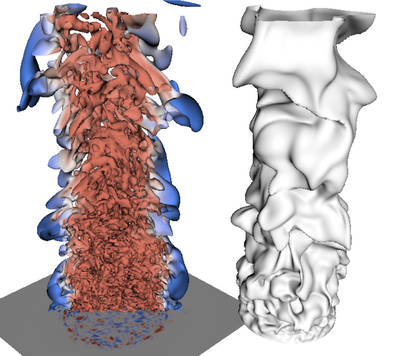
|
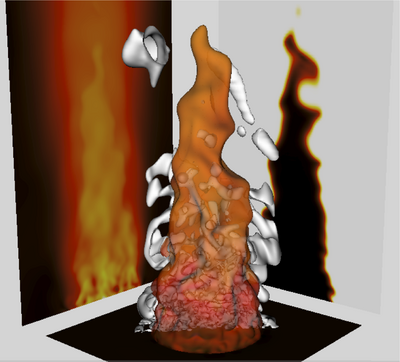
|
| Premixed jet flame | Bunsen flame |
- L. Vervisch, P. Domingo, G. Lodato, D. Veynante (2010) Scalar energy fluctuations in Large-Eddy Simulation of turbulent flames: Statistical budgets and mesh quality criterion Combust. Flame 157(4): 778-789.
- D. Veynante, G. Lodato, P. Domingo, L. Vervisch, E. R. Hawkes (2010) Estimation of three-dimensional flame surface densities from planar images in turbulent premixed combustion Exp. in Fluids 49:267-278.
Nonpremixed jet flame
Detailed chemistry tabulations are mostly based on reaction progress variables used to track species evolutions along trajectories in composition space, which in some cases are obtained from simulations of prototype combustion problems. For hydrocarbon chemistry, these progress variables are usually built from major species, as CO, CO2, H2O to which reactants are sometimes added. Prediction of NO mass fraction is first evaluated by comparing results from single progress variable and flamelet based chemical look-up tables against simulations of reference flames performed with the detailed chemistry mechanism that was used to generate the tabulations. Nitric oxides mainly formed in the burnt gases still evolve once major species have almost reached their equilibrium levels, then large errors in the predictions of NO mass fractions are unavoidable when using a progress variable based on major species only. It is concluded that the time scale separation inherent to NOx species must be included in the progress variable definition. A novel definition of progress variable is proposed for flame based tabulation and tested, which allows for reproducing both major species as well as NO, NO2 and N2O. Large-Eddy Simulation (LES) of a jet flame in a vitiated coflow is performed with the new tabulation and results are compared against experiments.
- G. Godel, P. Domingo, L. Vervisch (2009) Tabulation of NOx chemistry for Large-Eddy Simulation of non-premixed turbulent flames Proc. Combust. Inst. 32: 1555-1551.
DNS of a non-reacting HIT
This is a very simple DNS computation of a HIT with a constant-properties gas.
The main parameters of the simulation are:
- temporal integration: RK3,
- spatial scheme: 4th order skew symmetric
- no AV.
In this series of computations, the number of cell is increased from 64^3 to 256^3.
